John Charles Stovin, 1814-1896,
microphotograph slide maker “J.S.” / “J.C.S.”
by Brian Stevenson
last updated November, 2025
Microphotograph slides bearing the phrase “a photographic curiosity” are moderately common in antique slide collections and for sale at auctions. Most also carry the initials “JS”, although sometimes the middle initial is given, “JCS” (Figure 1). Stanley Warren (2006) presented a well-researched case which concluded that JS/JCS was John C. Stovin. Further evidence that confirmed the identification of Stovin was provided by the recent discovery of an 1881 publication by John Nicol, who wrote “Nearly twenty years ago I was presented by the maker, Mr. J.C. Stovin, of London, with a box of ‘London in miniature’ - a series of thirty-six microscopic reductions of stereoscopic views of London - microphotographs mounted in the usual way on slips of glass with glass covers cemented on with Canada balsam” (Figure 2).
As described in depth later in this essay, Stovin also produced small hand-held magnifiers of turned ivory or wood, for use in viewing circular versions of his microphotographs (Figure 3).
Some
Stovin photographs can be dated by their subject matter, ranging between 1859
and 1862 (Figures 4-8). How much longer Stovin produced his curiosities is not yet known. He was reported to have operated a photographic studio from his home between those years, with the house serving only as a private residence after 1862. Stovin is known to have produced about 120 images with “JS” labels and 30 using the “JCS” variant.
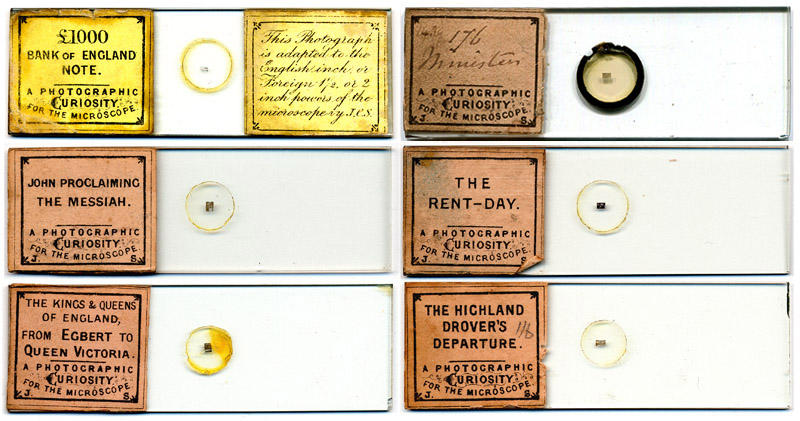
Figure 1. Examples of microphotograph slides by J.C. Stovin. The majority of his slides bear one, pale brown label and the initials “JS”. As Warren (2006) pointed out, the use of two initials on the “JS” labels achieves artistic balance. Others carry two yellowish labels and the initials “JCS”. The vast majority have labels with typeset descriptions of the microphotograph - the slide at upper right is a rare exception, with a handwritten description (presumably, Stovin's handwriting).
Another producer of microphotographs, the as-yet unidentified “EM”, used similar labels, and may have been a colleague of Stovin’s, they may have copied each other, or simply patronized the same printer.
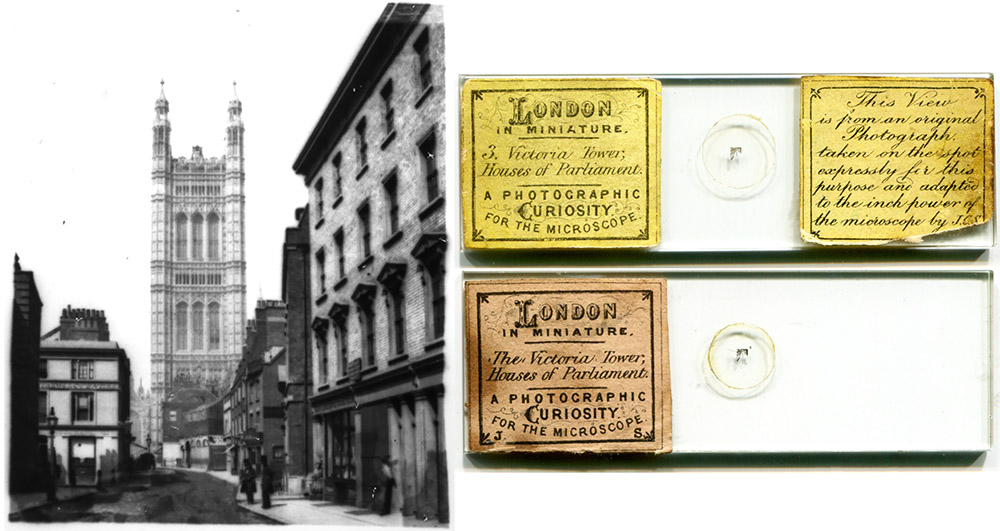
Figure 2. A microphotograph from the “London in Miniature” series. Stovin exhibited examples of this and ten other microphotographs at the 1862 London Exposition. According to Nicol (1881), Stovin expanded this series of microphotographs to 36 different views. Examples of several from this series are illustrated below.

Figure 3. A Micrograph set, with turned ivory viewer and circular glass microphotographs, attributable to John Stovin. As discussed in the text and by Stanley Warren (2014), the popular attribution of the Micrograph to John B. Dancer is almost certainly false. Other sets are known with turned wood viewers and/or 24 microphotographs.
John
Charles Stovin was born August 27, 1814, in East Retford, Nottinghamshire. He
was the first child of George Charles and Anne Charlotte Spilsbury Stovin.
Father
George was an officer in the Royal Navy. Although Stovin only reached the rank
of Lieutenant, he was frequently referred to as “Captain Stovin”, in that he
once commanded His Majesty’s ship Algerine.
It is for that command that he is best remembered, having been mutinied
against. Apparently, while serving in the area near China during 1834, Lt.
Stovin was repeatedly so drunk that his junior officers felt him unfit to
command, locked him in his cabin, and took control of the ship. The junior
officers were later court-martialed for mutiny, and Stovin was court-martialed for not having put up any resistance:
“A Court-martial assembled on board his
Majesty's ship Victory, in Portsmouth Harbour .. for the trial of Lieutenant
George Charles Stovin, late in command of the Algerine, on charges of repeated
acts of drunkenness and unofficer-like conduct, committed by him between the
6th of September and the 4th of November (1834). The Court having heard and
examined the evidence in support of the prosecution, and having heard what the
said Lieut. George Chas. Stovin had to allege in
his defense, and having heard the evidence adduced by him in support thereof,
and having carefully and deliberately weighed and considered the whole, the
Court is of opinion that the said charges have been proved in part,
particularly the most unjustifiable conduct of the said Lieutenant G.C. Stovin,
in allowing the command of his Majesty's brig Algerine to be taken from him by
an inferior officer, on the 4th of November last, and which command the said
Lieutenant Stovin, notwithstanding his then ill state of health, ought to have
exerted himself to the utmost to retain, and to have commanded the officers and
crew of the said brig to support him in so doing to the last extremity; but in
consequence of the ill state of health in which the said Lieutenant G.C. Stovin
was stated to be at the time of the said proceeding, and in consequence of the
former active and intrepid services rendered by the said Lieutenant G.C.
Stovin, and of his general good character prior to his joining his Majesty's
ship Algerine, the Court doth only order and adjudge that the name of the said
Lieutenant G.C. Stovin shall be placed at the bottom of the list of Lieutenants
of the Royal Navy, and shall not be raised therefrom; and that he, the said
Lieutenant Stovin, shall not be again employed in active service; and he, the
said Lieutenant G.C. Stovin, is hereby so sentenced accordingly."
Another scandal hit the Stovin family in 1838. Daughter Sarah Ann had married one Henry Napier Disney, a.k.a. Henry Battersby, a.k.a. Arthur Battersby. Unfortunately, Henry was already married. John Stovin was instrumental in tracking down records of the previous marriage. Disney/Battersby was arrested and tried at Old Bailey for bigamy. Being found guilty, he was transported to Australia.
Despite the scandals, the Stovin family retained a level of honor in society. For example, the children’s marriages were reported in The Gentleman’s Magazine.
From that
resource, we learn that John C. Stovin married Mary Jones, “the only Dau. of the Rev. T. Jones”, on
February 19, 1851. The 1851 census, compiled shortly thereafter, reported John
and Mary to be “visitors” (boarders)
at a home in Marylebone, London. John (misprinted as “James”) was described as being a “general merchant”. In 1852, John dissolved a partnership he had
with William Bibbens and Robert Blagden, with Bibbens and Blagden continuing
that business and Stovin taking up other work. Additional references on Bibbens
and Blagden suggest that they operated an import/export business, so presumably
their partnership with Stovin was in that same vein.
Available records indicate that Stovin participated in a variety of other business ventures throughout his life. The 1859 christening record of his second son, George, listed John’s occupation as “gentlemen”. While members of both the rich and the working classes might describe themselves as such on censuses, Stovin actually did move in affluent circles. In 1852, Stovin was involved in a scheme to raise funds to invest in Ecuador. He was associated with a mining company in 1862, Stovin was a partner in the Provincial Banking Corporation, Ltd., in 1865. In 1867, he was recorded as being a Director of the Oil and Lamp Black Company.
At the time of the 1861 census, John Stovin considered himself to be a “photographer”. PhotoLondon reports that Stovin operated a photographic studio from White Lodge, Keppel Street, Chelsea, between 1859 and 1860. His studio then partnered with Charles Thorp between 1861 and 1862, working from the same address. Stovin’s photography business appears to have ended after 1862.
The 1861
census listed the Stovin’s home address as “White
Cottage, Keppel St., Chelsea”. Son George’s christening record described
the home as “Whitehead’s grove”. That
address was also given for “Stovin and
Co.”, who exhibited “microscopic
photographs” at the 1862 London International Exhibition. Additional
records, including the 1871 census, refer to the 72 Keppel Street address, as “White Lodge” or “White Lodge, Whitehead’s Grove”, further confirming that the records cited by Warren (2006) do indeed refer to the John Charles Stovin in question.
At the
1862 London Exhibition, Stovin displayed both a group of microphotographs and a
set of eleven full-sized photographs of London’s “principal buildings”. The published descriptions of those large
photographs coincide with several JS slides labeled “London in miniature”, and it is likely they were from the same
negatives. Examples are illustrated in Figure 2.
A report of the Exhibition in The Photographic News noted, “reduced copies of pictures for microscopic examination; the results, although partaking of the character of toys, may yet become of important application. Mr. Reeves (United Kingdom, 3144), Mr. Stovin (United Kingdom, 3163), and M. Dagron, France, 1546), exhibit interesting specimens in this class”. It is notable that this magazine ignored the microphotographs of John B. Dancer, who also displayed at the 1862 London Exhibition.
There is also strong evidence that Stovin sold sets of circular microphotograph slides and a small magnifier, with a Coddington-type lens (Figure 3). The microphotograph slides are only 19mm in diameter. Most known "Micrograph" viewers are made of turned ivory, although two are known that were made of wood. Accompanying instructions state that these devices were "exhibited at the International Exhibition 1862 Class 14". Although the Micrographs have often been attributed to J.B. Dancer, there is no evidence for that hypothesis, other than the fact that Dancer attended the Exhibition. Stanley Warren (2014) presented a compelling argument in favor of Stovin as the maker, including evidence that 73 of the microphotographs known to accompany Micrograph sets were also produced as 1x3 slides by Stovin, while only 13 of them match Dancer productions (all of the Dancer matches are common pictures that were produced by numerous microphotographers).
At the time of the 1861 census, the Stovins employed a live-in servant, indicating that they were moderately well-off. Stovin’s wife, Mary, died during the spring of 1861. On September 24, 1863, John Charles Stovin “widower, gentleman”, married Elizabeth Russell Curling, 10 years his junior.
A man of his times, John Stovin was a creative inventor. In 1865, “John Charles Stovin, of Whitehead's-grove, Chelsea”, was awarded two patents for improvements “in the means of communicating signals from passengers in railway trains to the guards and engine drivers”. Later that year, he was awarded patent protection for improved methods to clean cotton seeds.
Records have been located that document Stovin’s involvement with a variety of businesses in England through 1867. The 1871 and 1881 censuses recorded Elizabeth as living at their home, White Lodge, 72 Keppel St., Chelsea, London. John was not at home during either census.
In late 1869, Stovin emigrated to New Zealand, as the maganger of the New Zealand Quartz-Crushing and Goldsmithing Company, Ltd. He was involved in a variety of mining enterprises for the next ten years (Figure 10). He departed from New Zealand in April, 18880, on a ship bound for the Hawaii and San Francisco, USA .
John Charles Stovin later returned home to England, and died on April 3, 1896, at the age of 83.
Figures 4-7. Datable microphotographs by John Stovin.
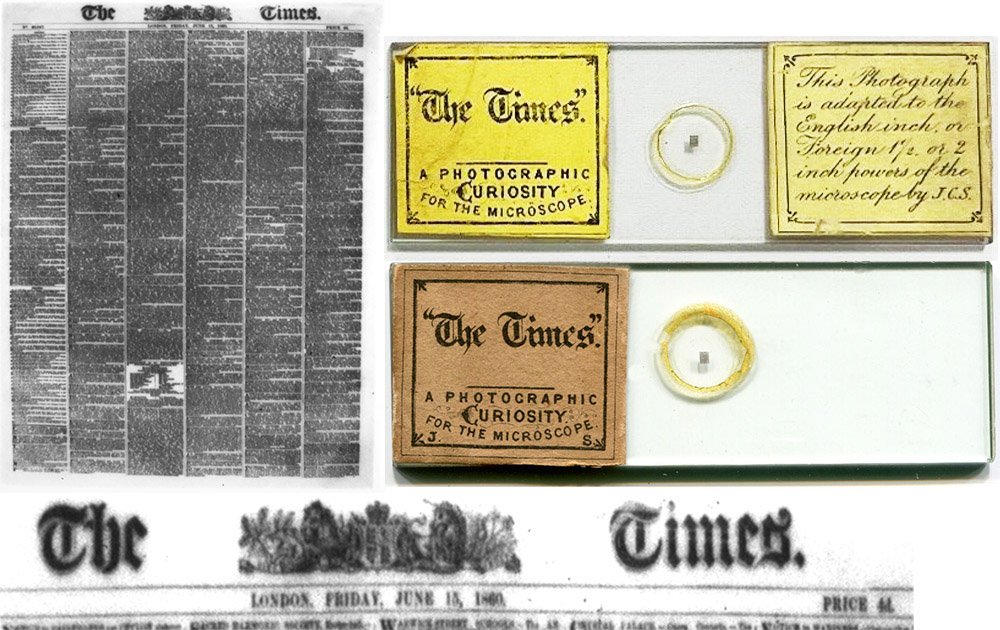
Figure 4.
Front page of the June 15, 1860 edition of the Times of London.
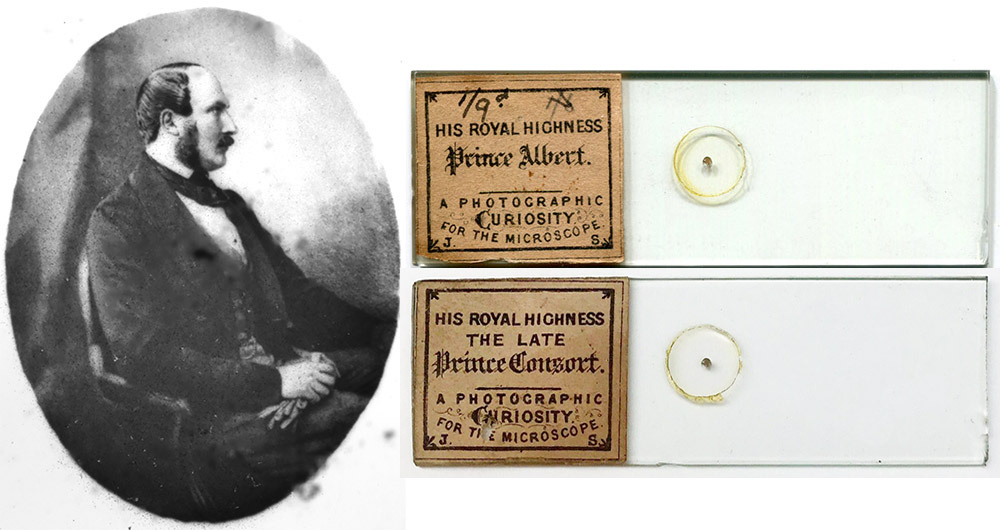
Figure 5.
“His Royal Highness Prince Albert”. This image was taken in May, 1860, by John Mayall (1813-1901), and released by him in August, 1860 as a carte-de-visite and in an album of the royal family. This Stovin microphotograph exists in two label variants, without and with ‘the late’. Prince Albert died on December 14, 1861.
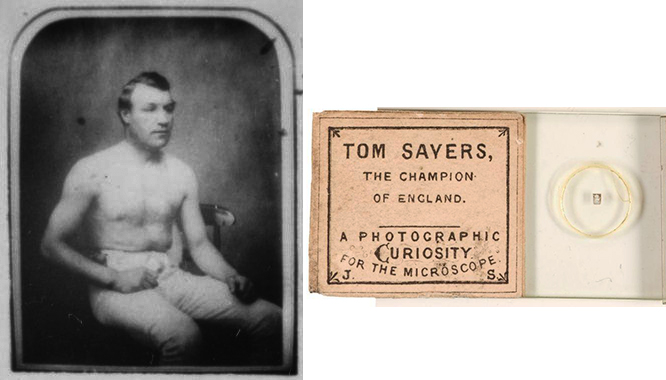
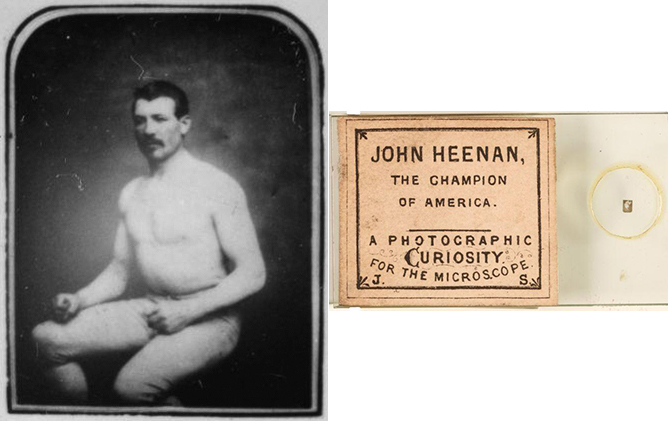
Figure 6.
Microphotographs of boxers Tom Sayers and John Heenan. The two men fought a celebrated bareknucked boxing match on April 17, 1860. The fight was declared a draw. The two men were awarded championship belts on May 30, 1860, in London, then toured the British Isles. They performed an exhibition fight on June 4, 1860, in Manchester. This pair of microphotographs undoubtedly dates from the time of the fighters' popularity.
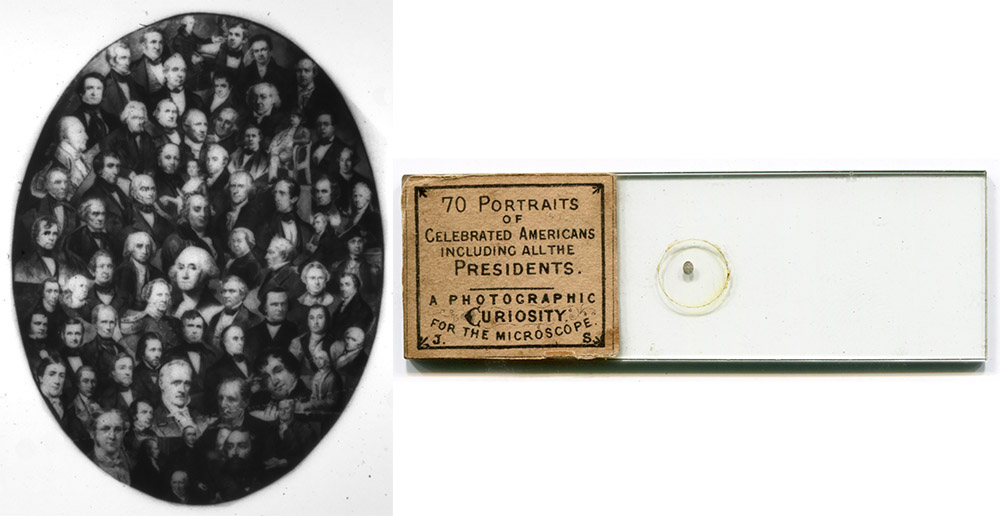
Figure 7.
“70 Portraits of Celebrated Americans Including All the Presidents”. The collage includes James Buchanan, who served from 1857 until March 4, 1861, but does not contain a picture of Abraham Lincoln, who was elected in November, 1860, and was sworn in on March 4, 1861.
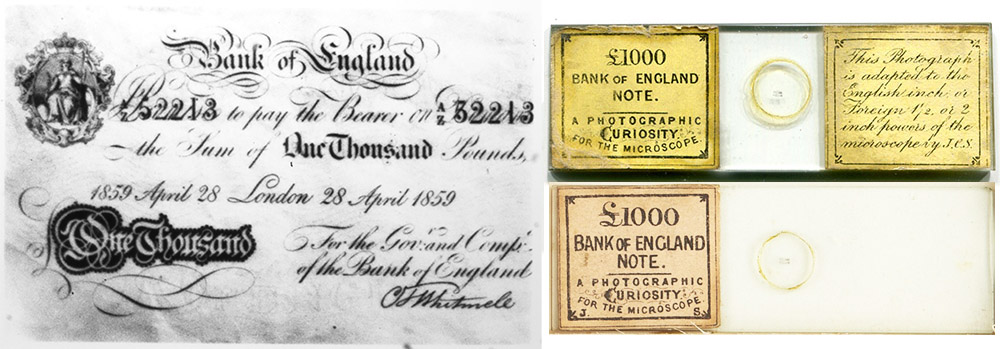
Figure 8.
“£1000 Bank of England Note” (an item which almost all of Stovin’s customers could only dream of holding). The note is dated 28 April, 1859, serial number 52213.
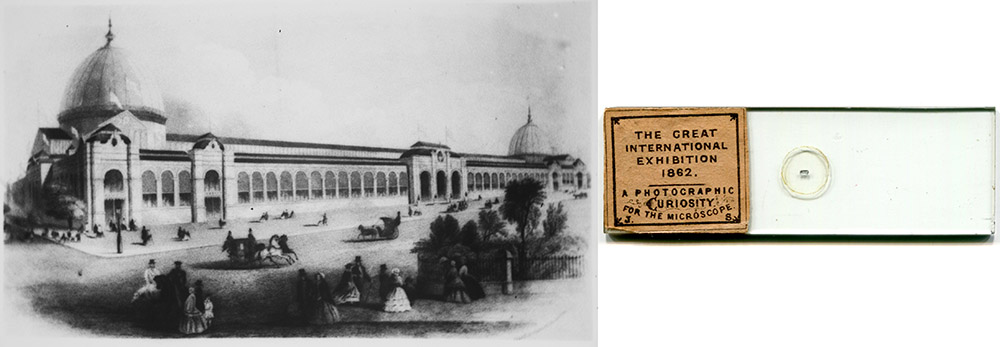
Figure 9.
“The Great International Exhibition of 1862” was held in London from May 1 to November 1, 1862.
___________________________________________________________________
A selection of microphotograph slides by John C. Stovin, from the collections of the author and generous contributors, or adapted for nonprofit, educational purposes from internet sale sites.
"London in Miniature" Series
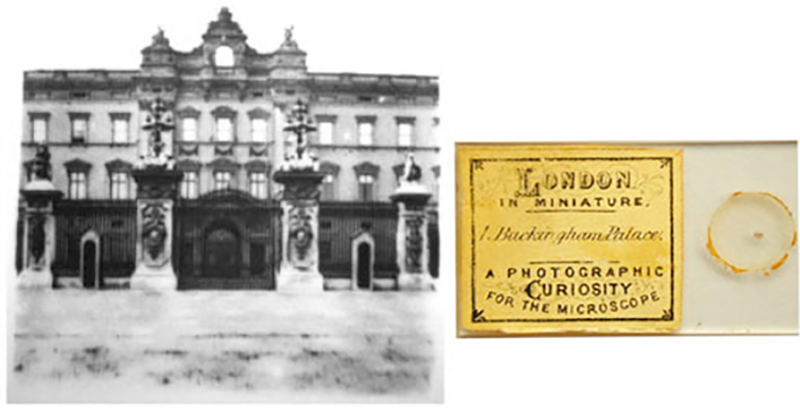
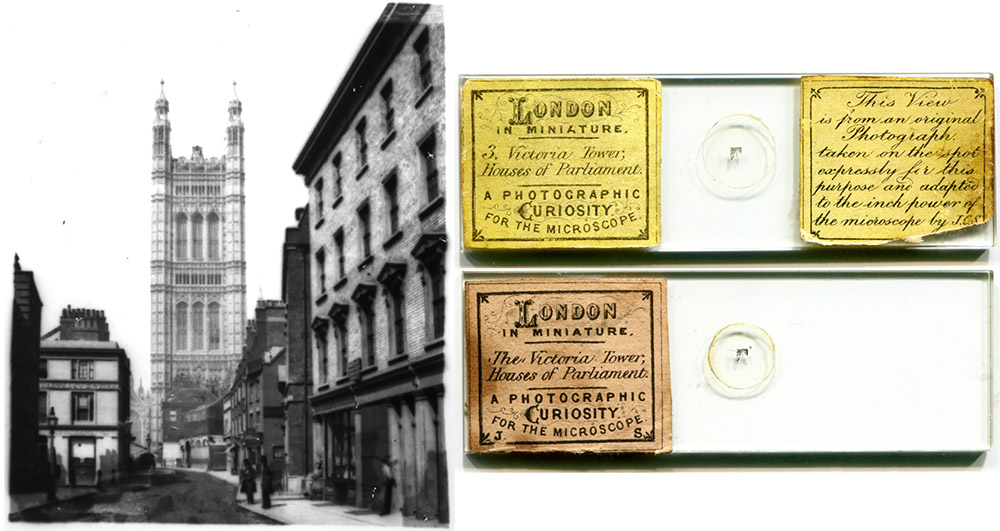
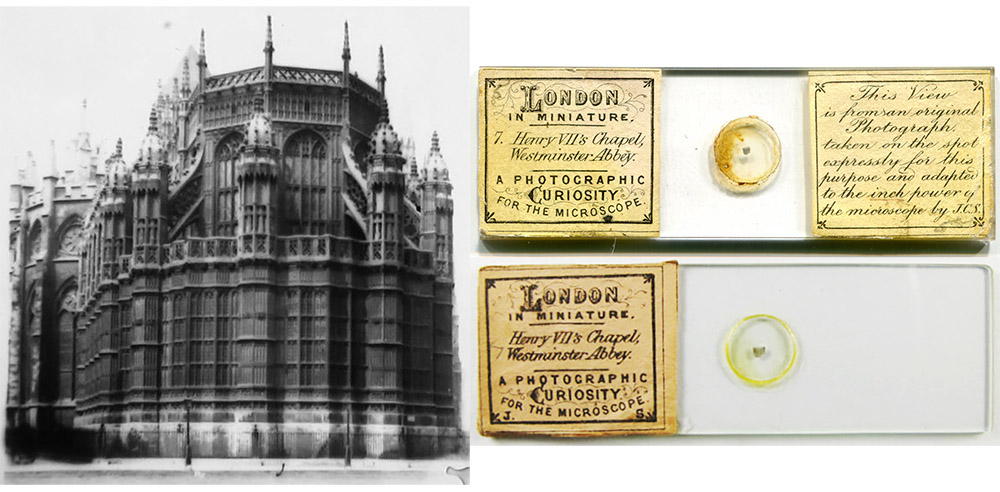

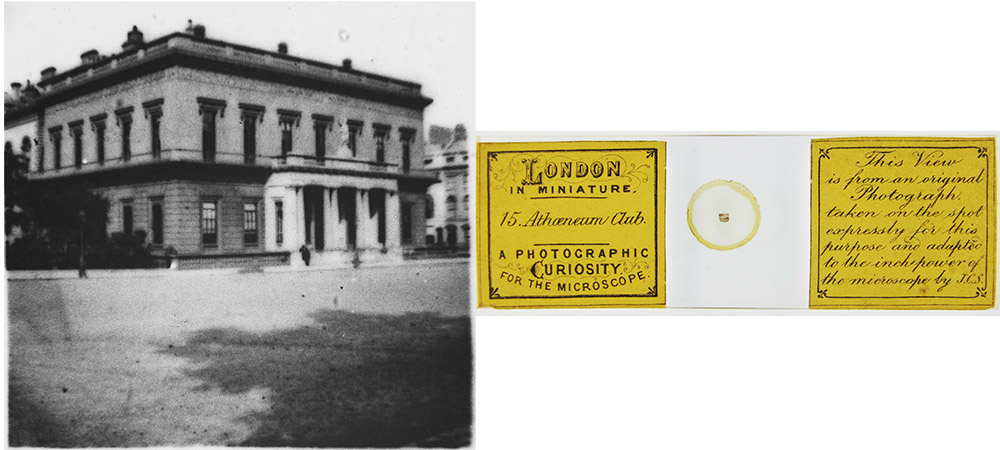
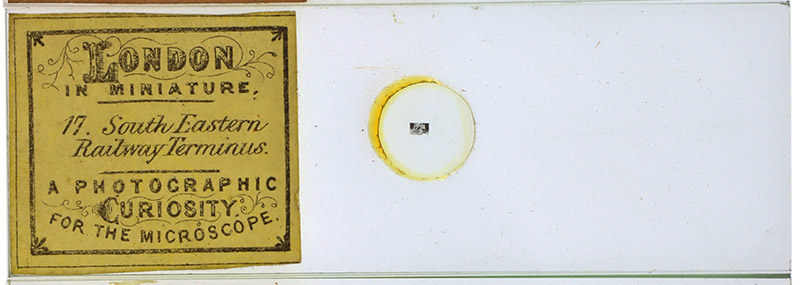
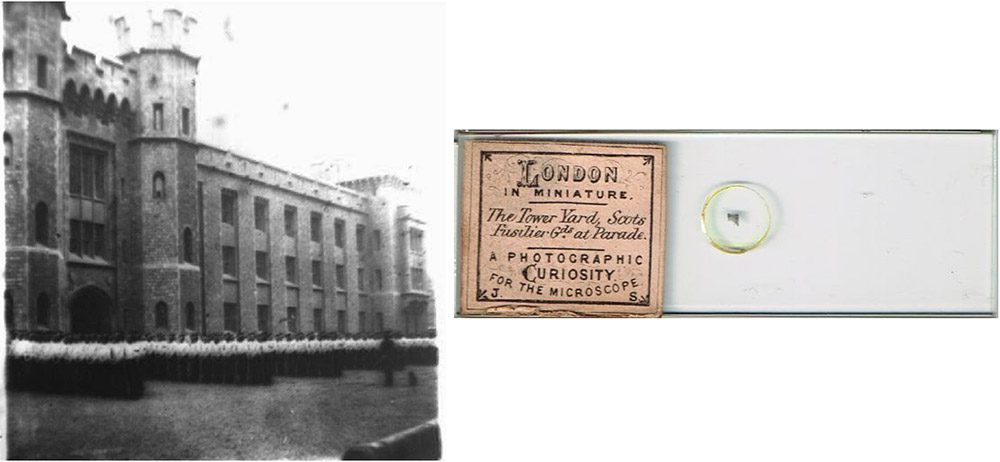
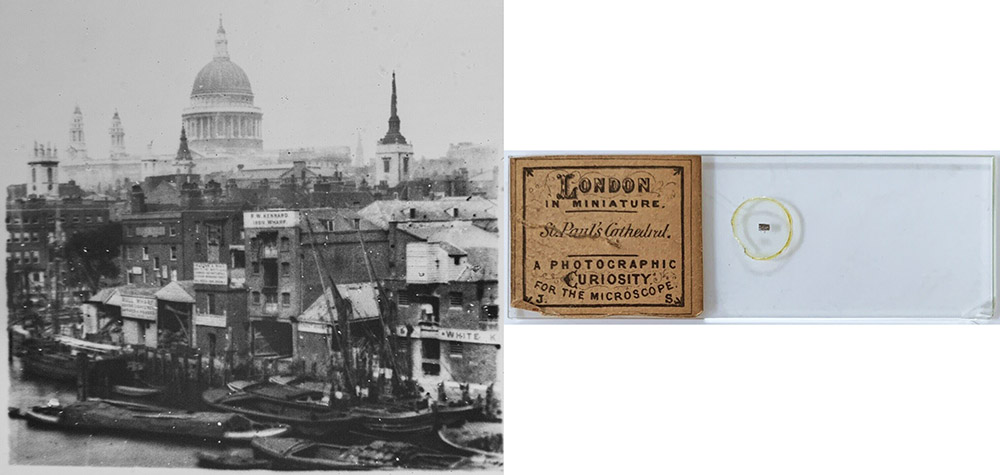
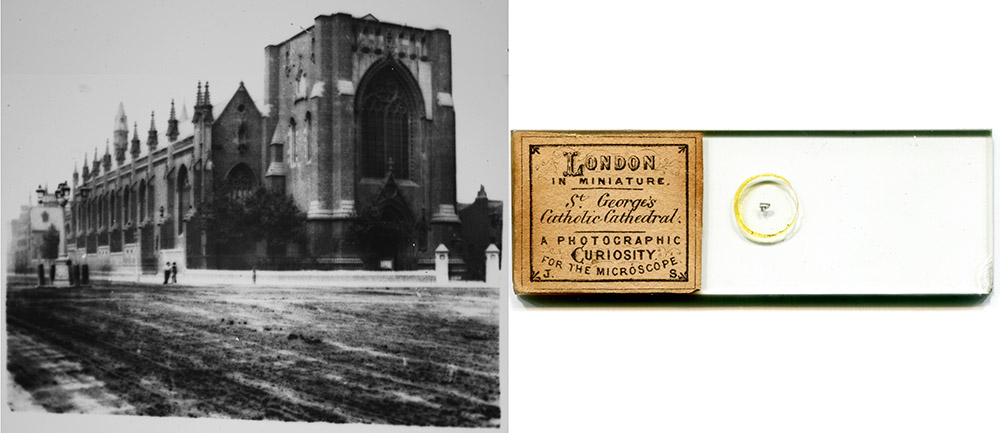
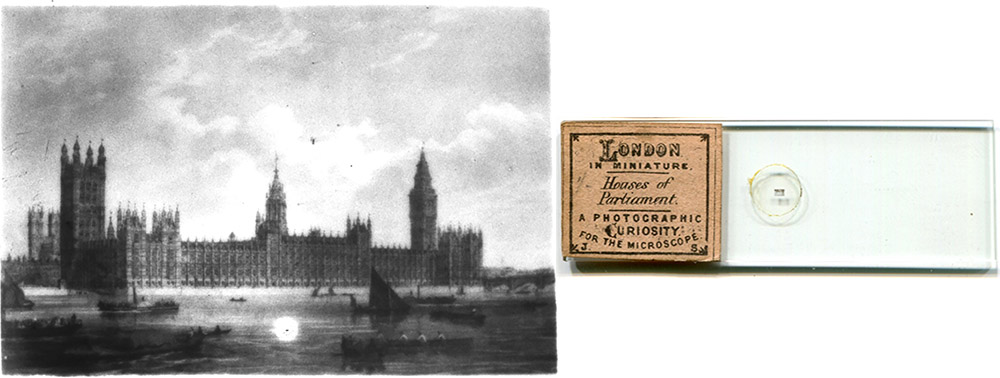
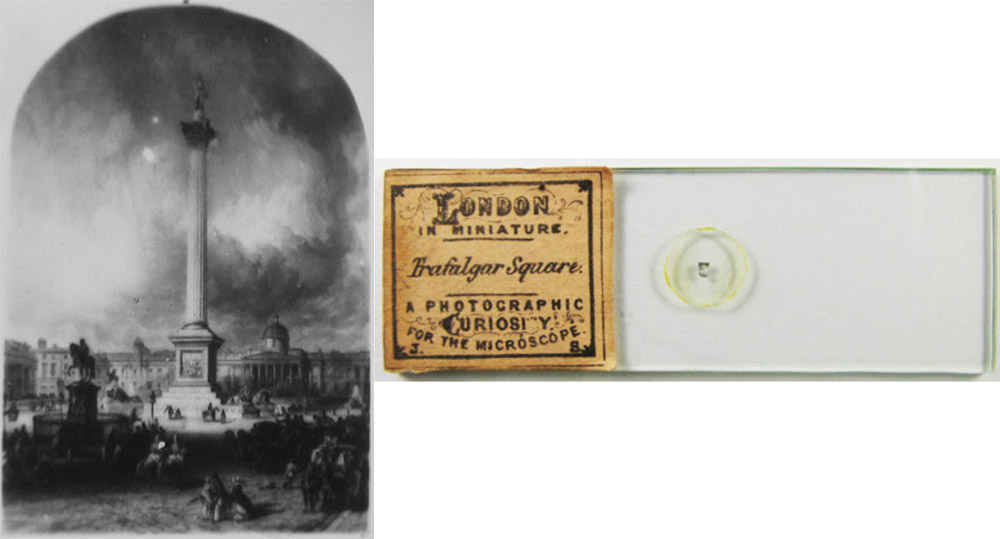
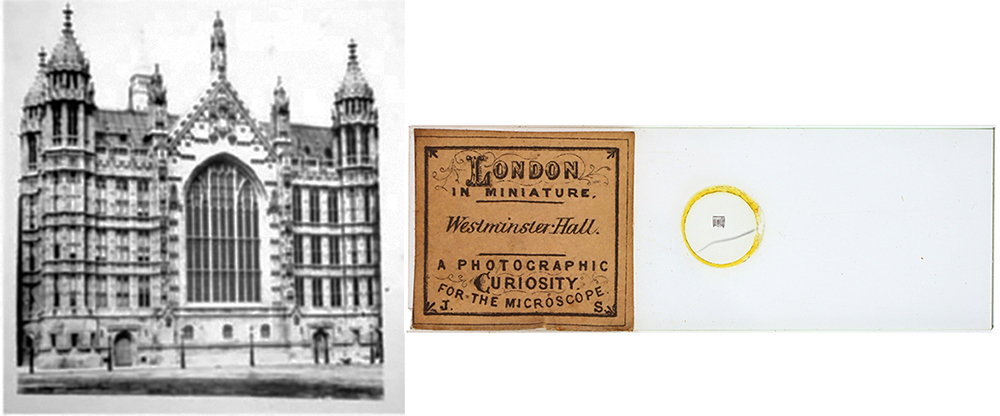
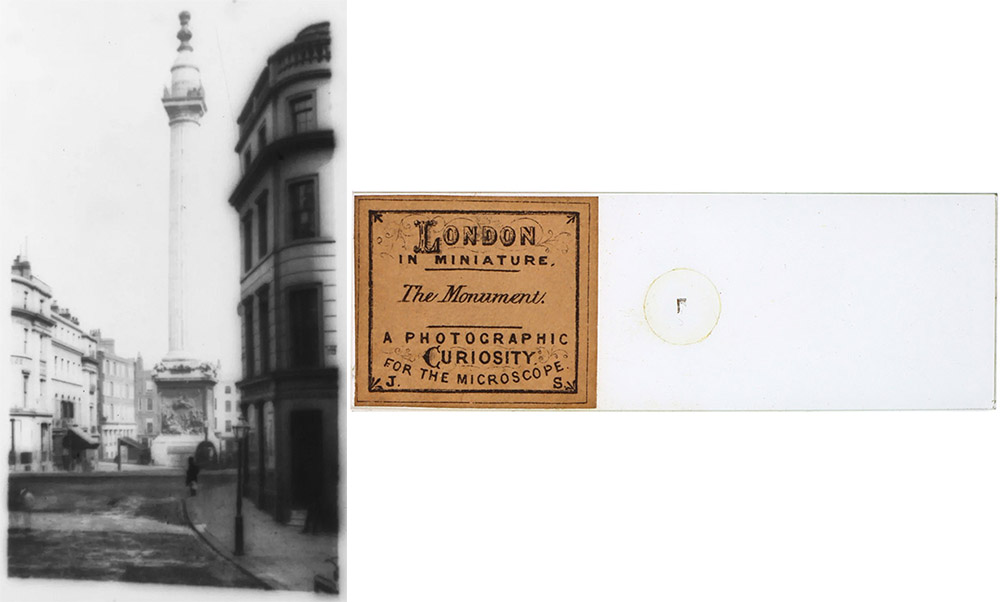
Portraits of Royalty and Celebrities
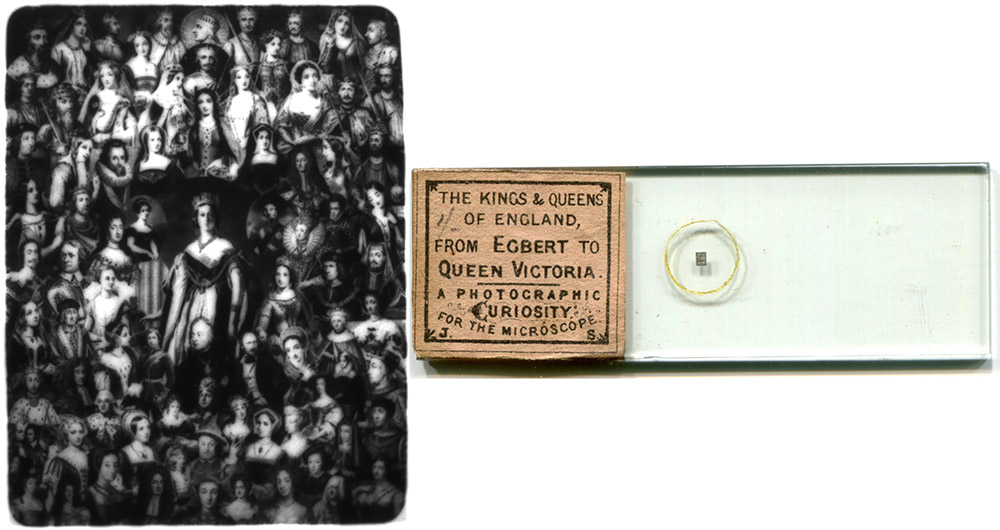
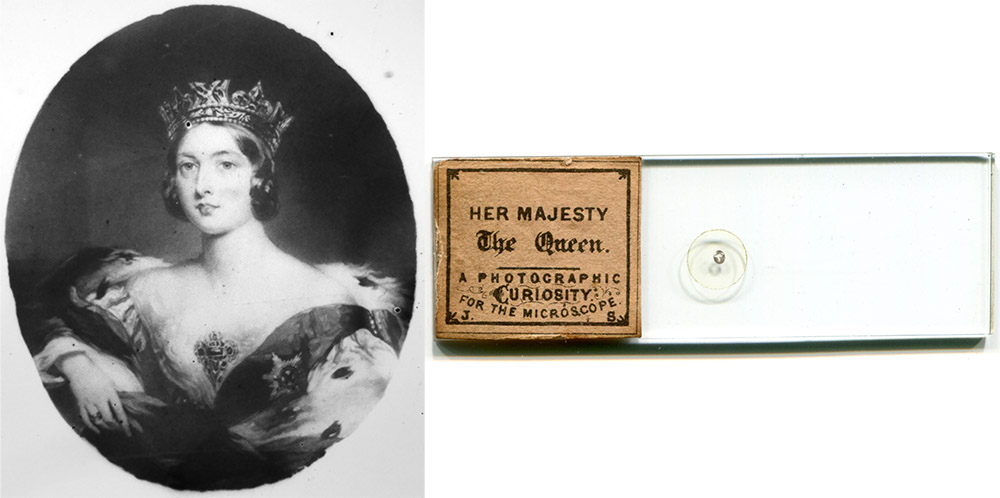
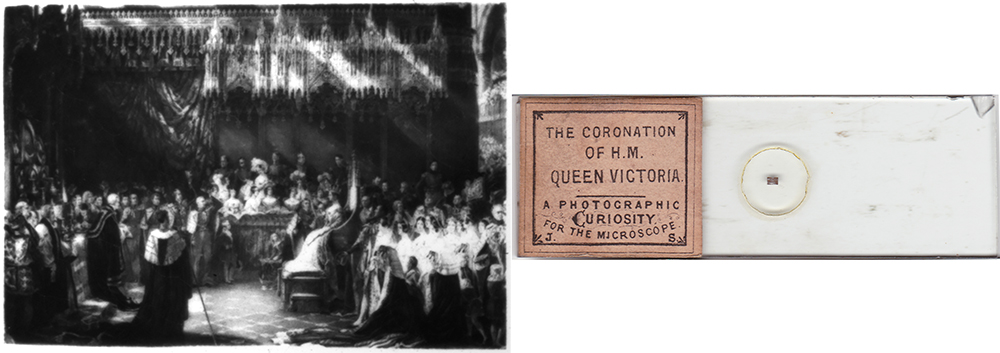
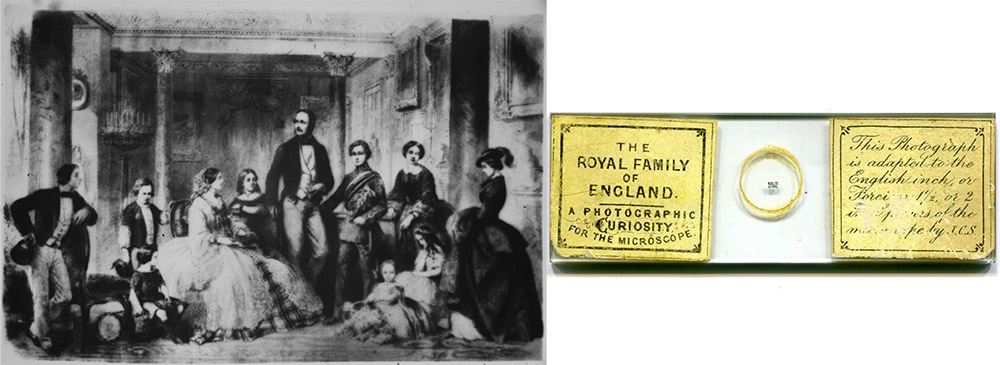
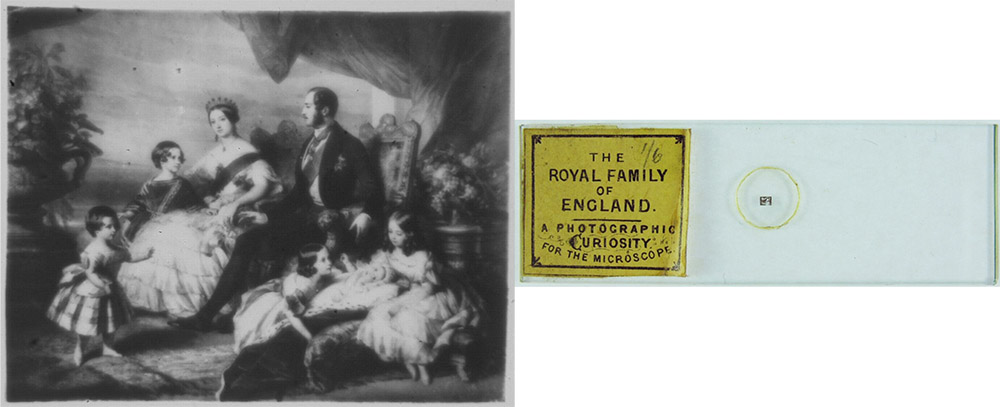
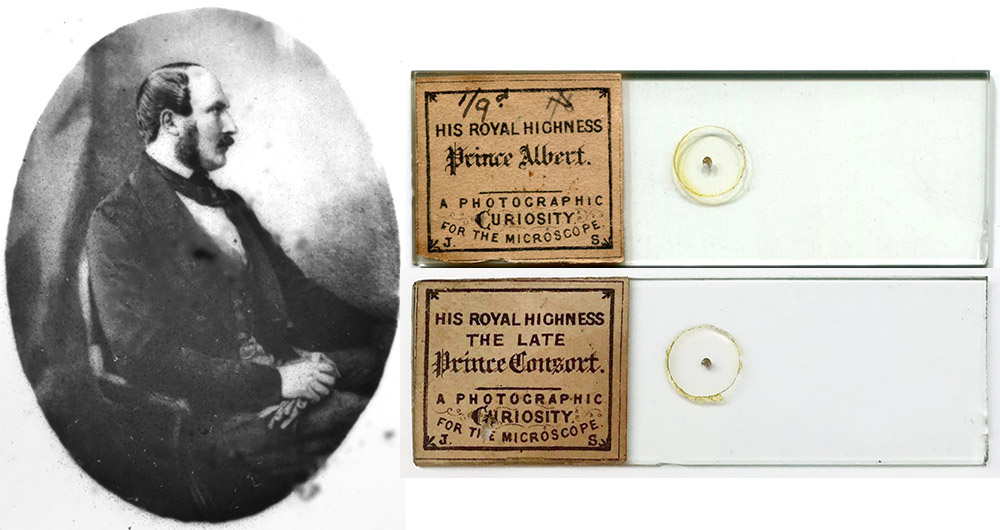

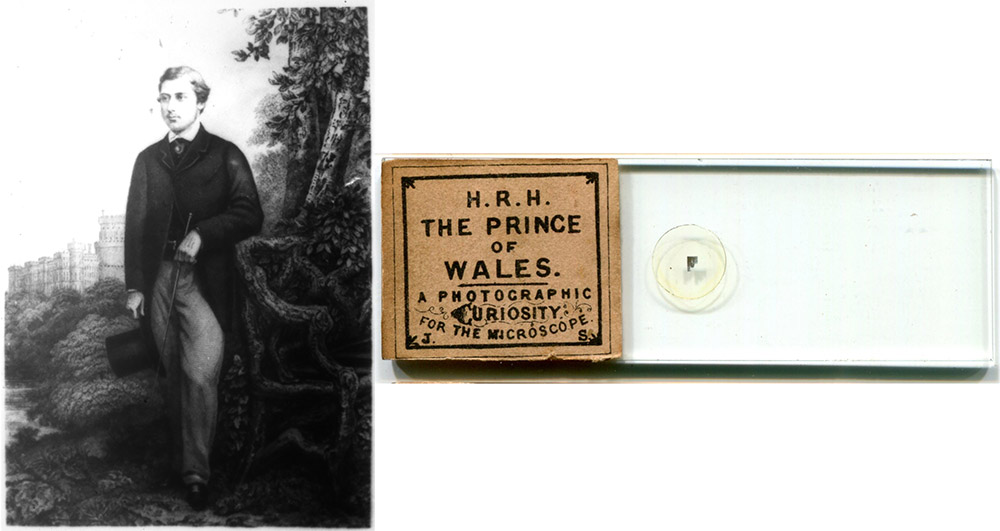
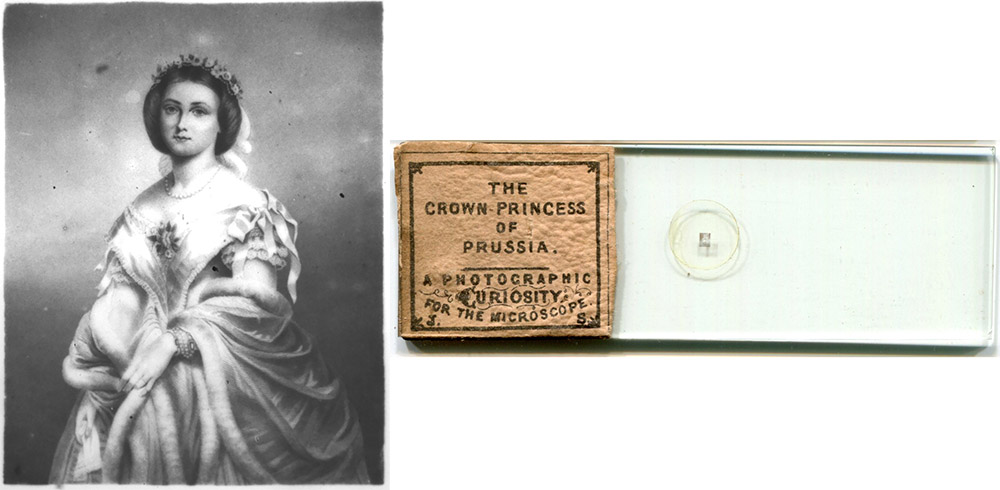

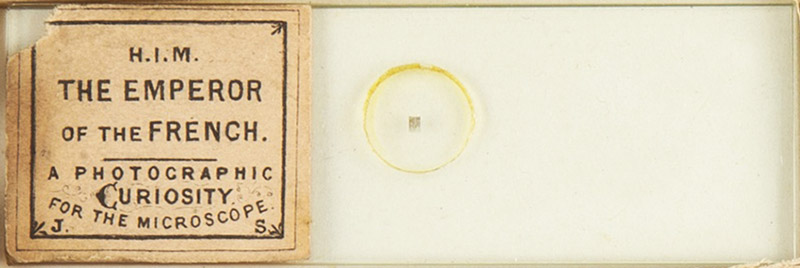


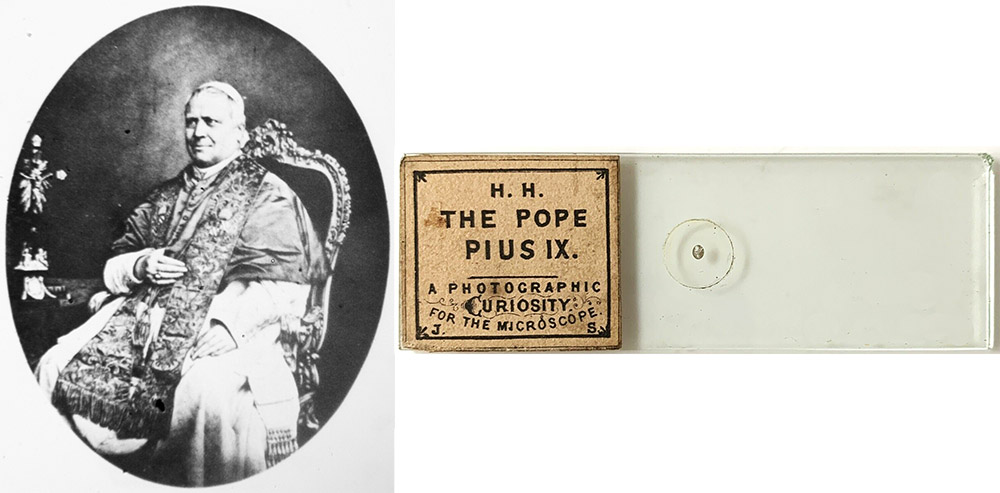
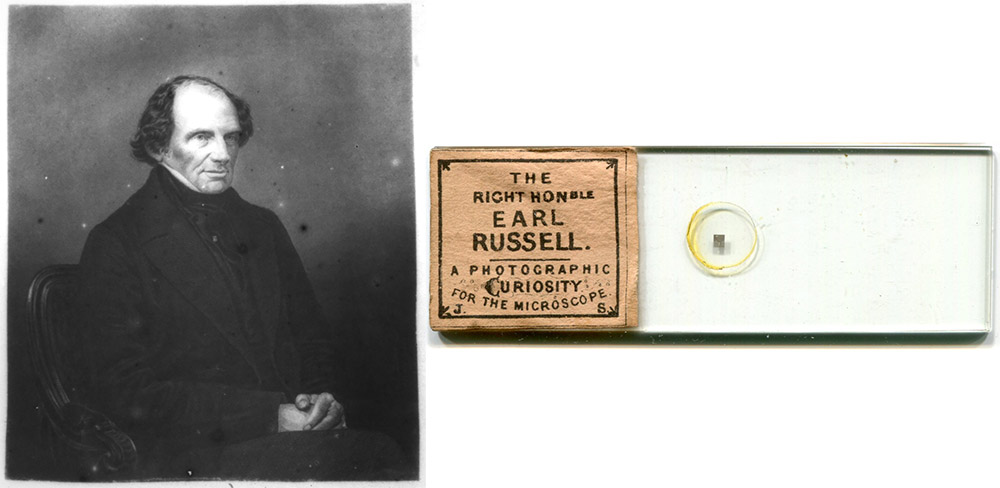

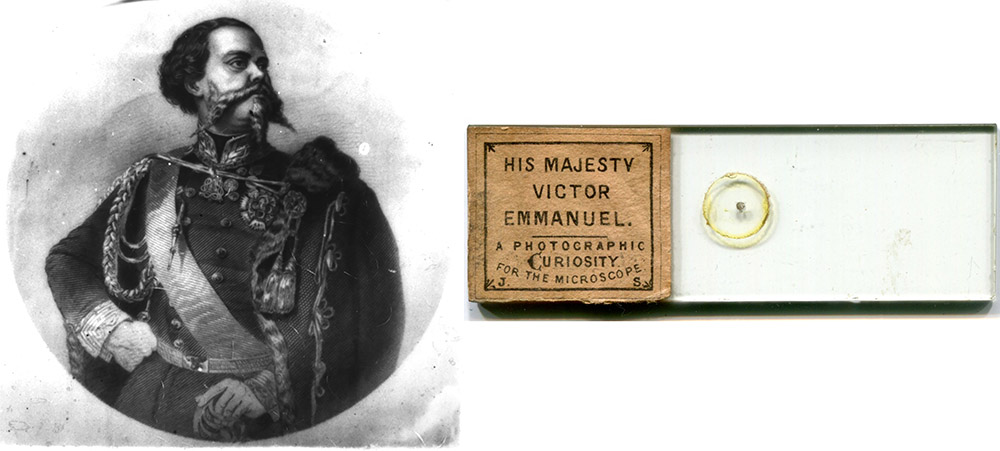
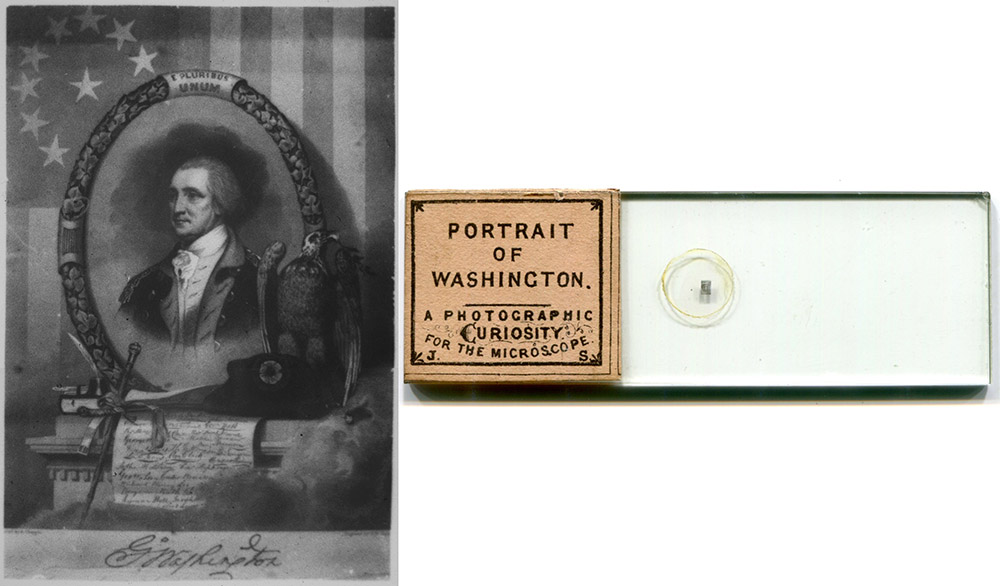
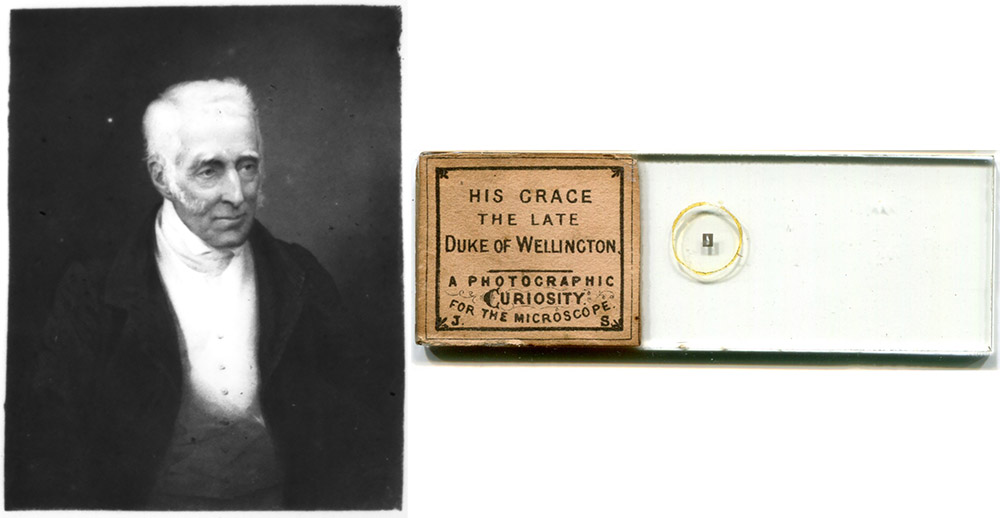
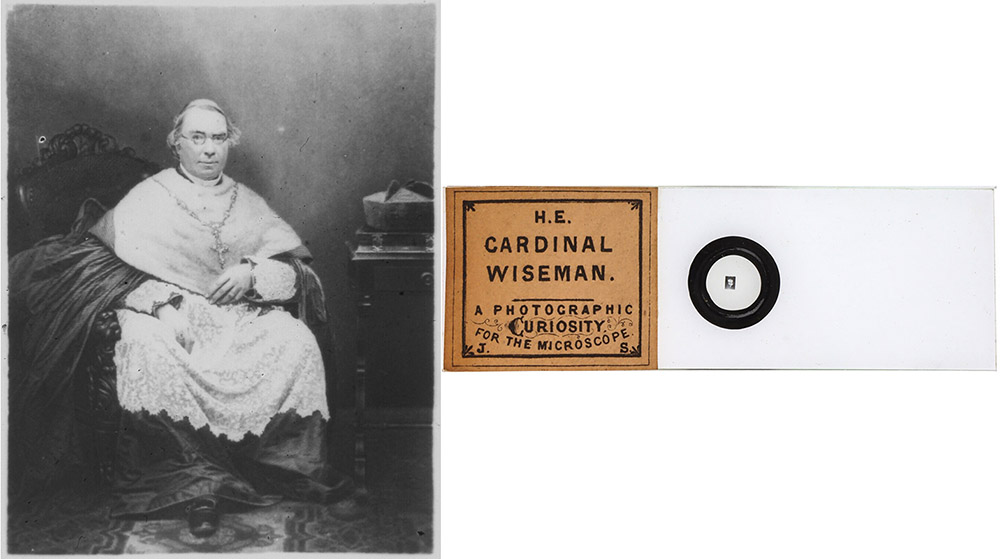
Collective Portraits of Famous People
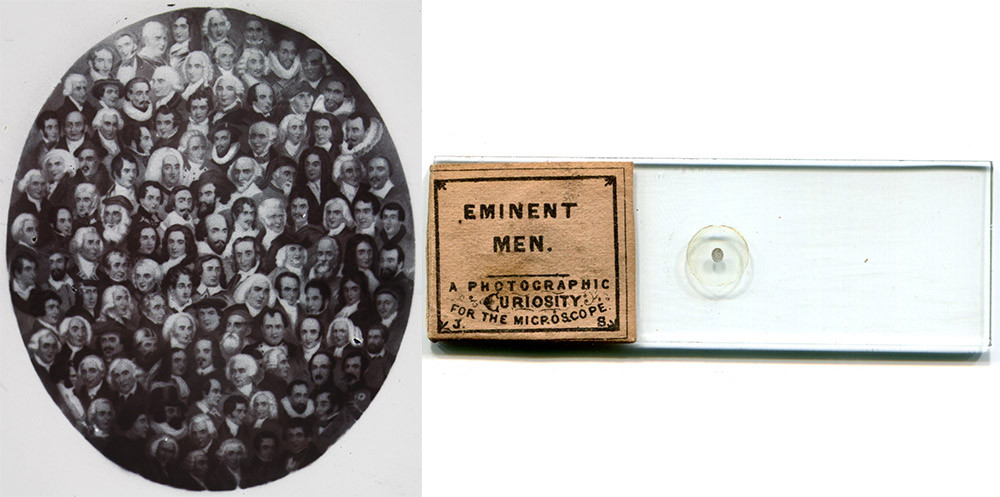
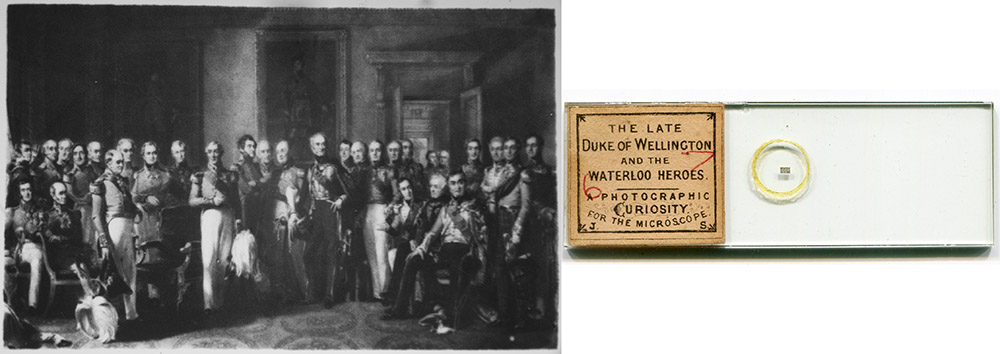
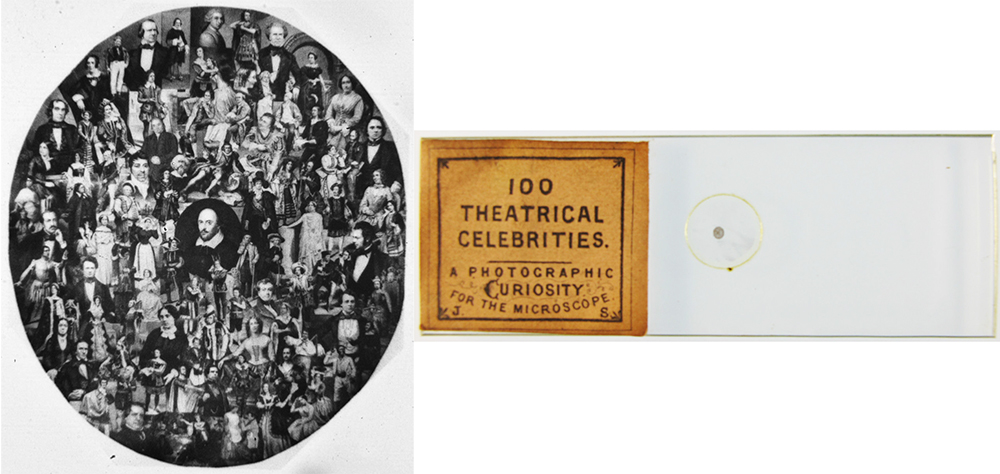
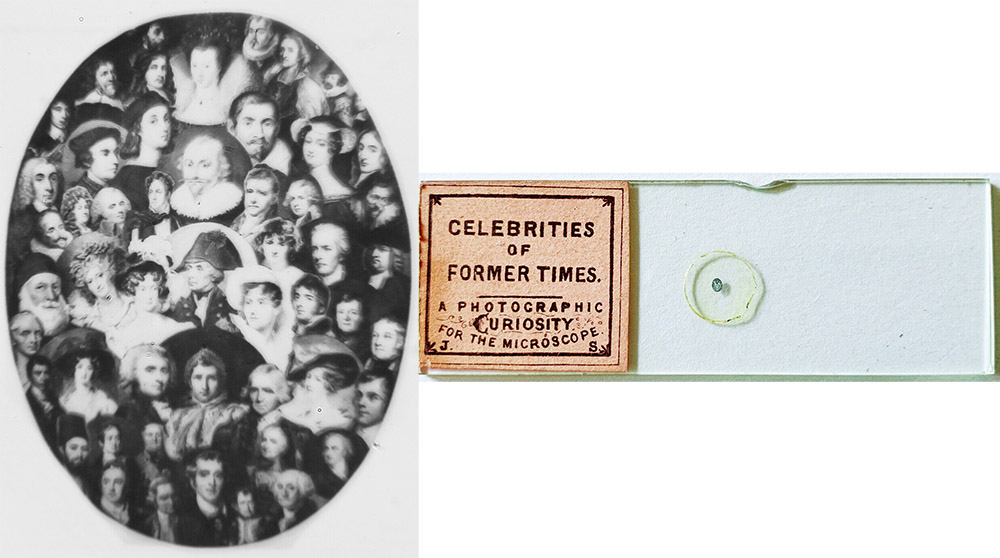
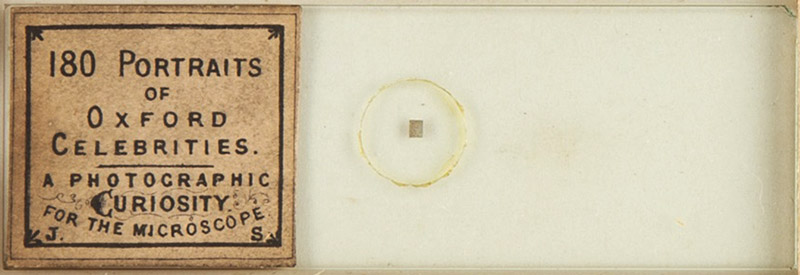
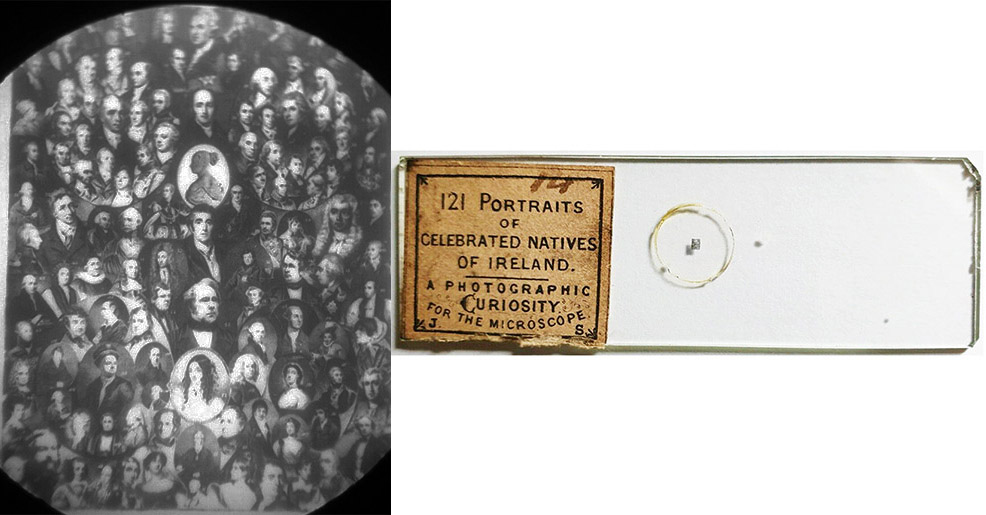
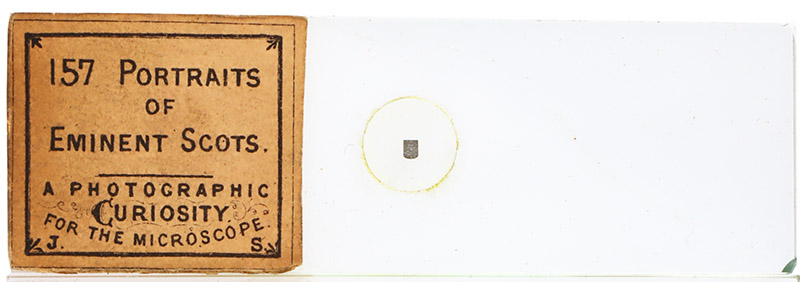
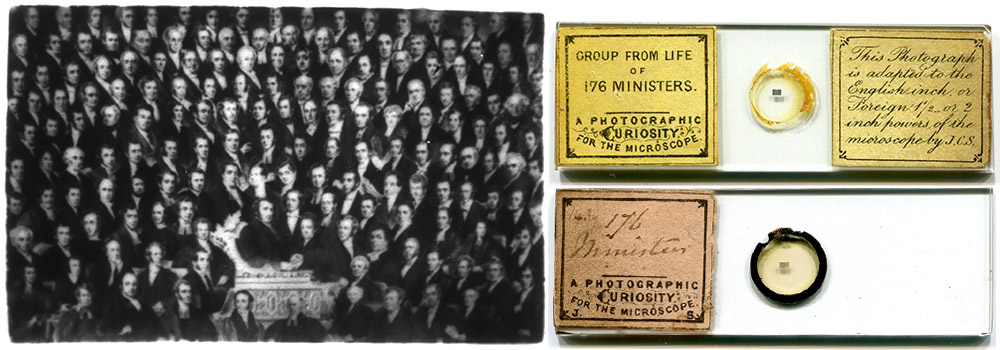
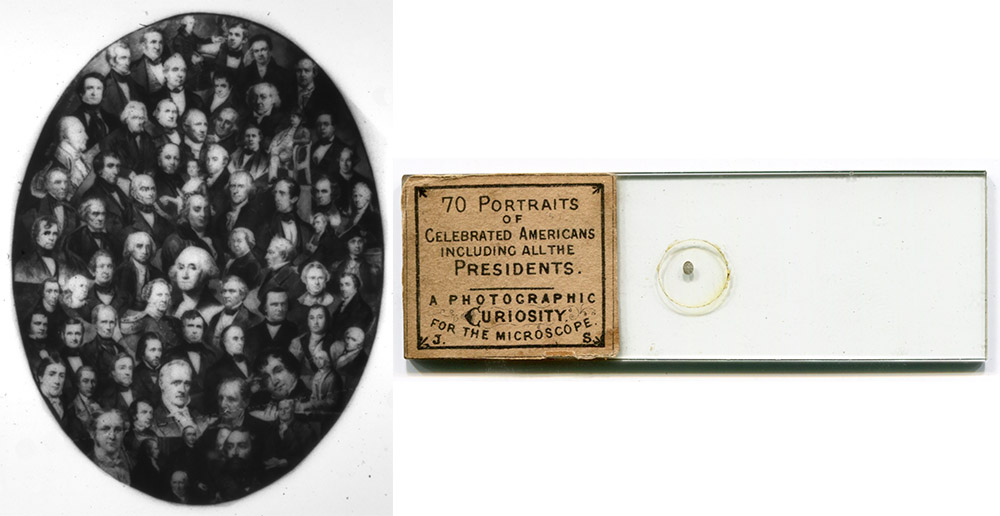
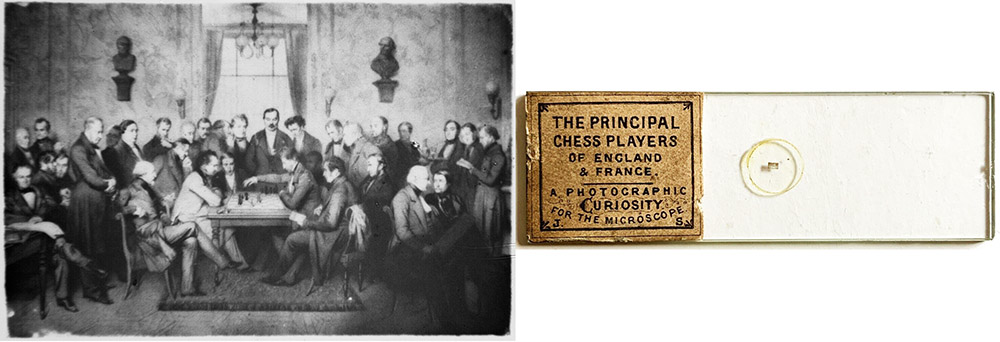
Popular Artworks, Scenery, Documents, etc.
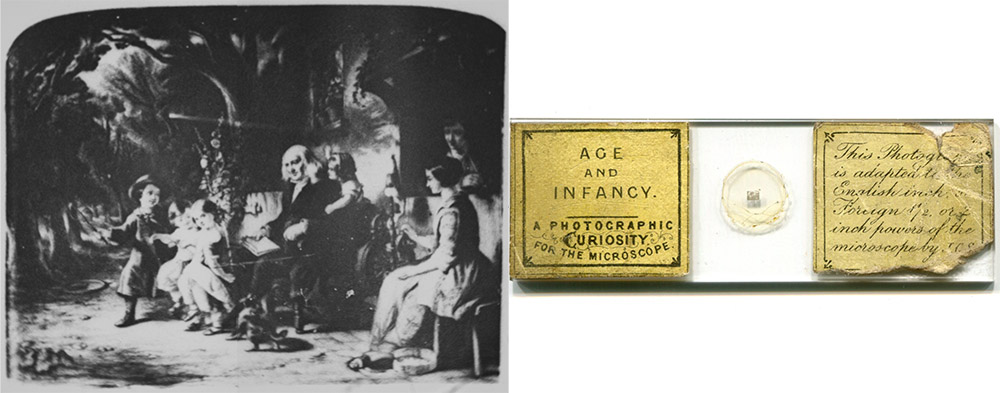
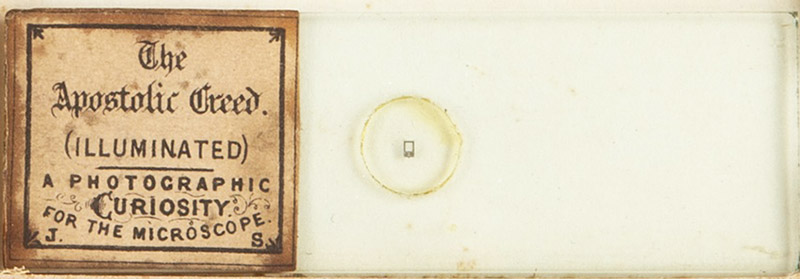
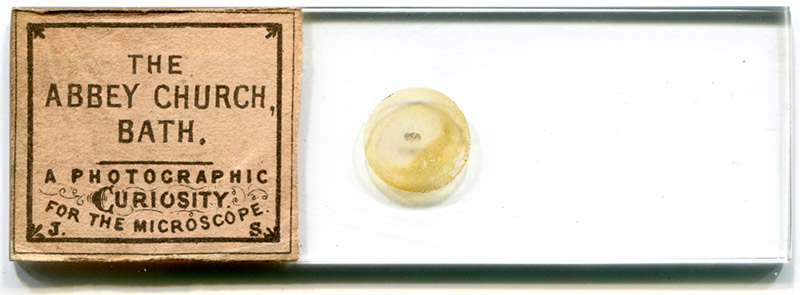
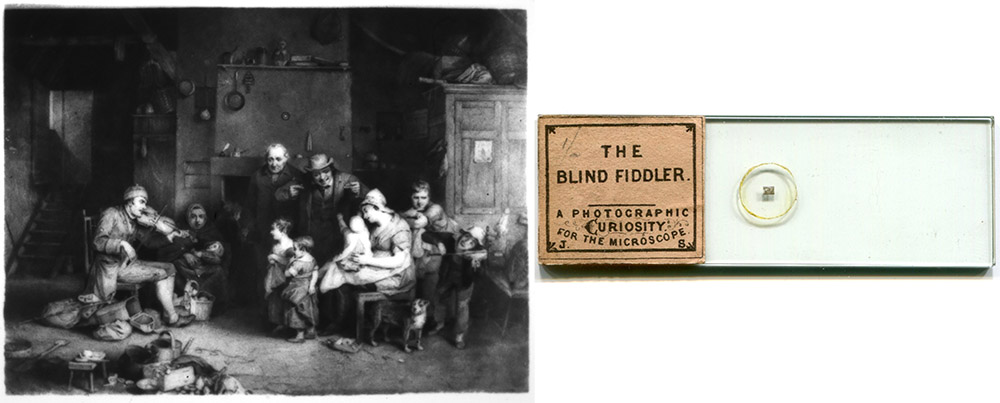
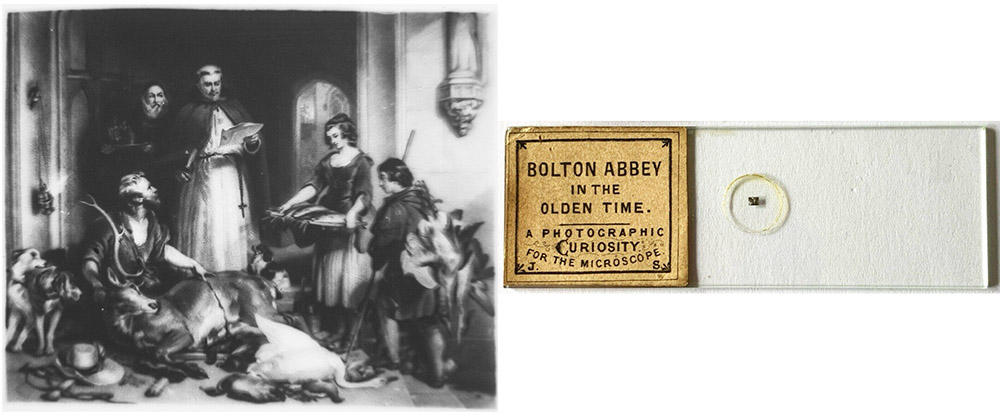
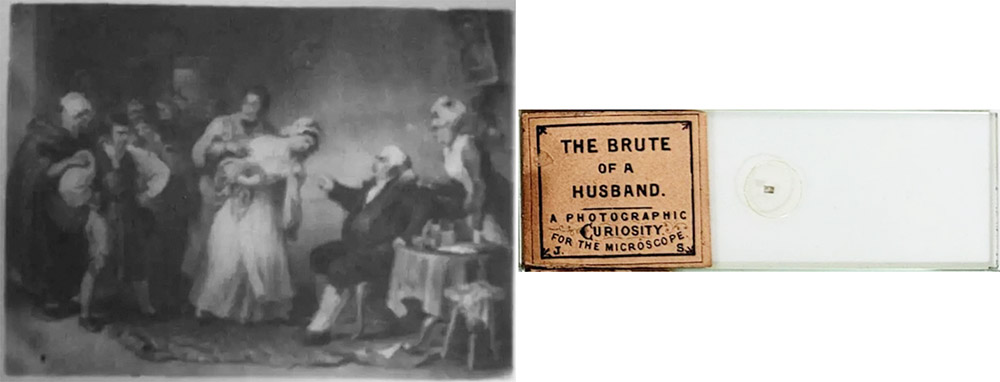
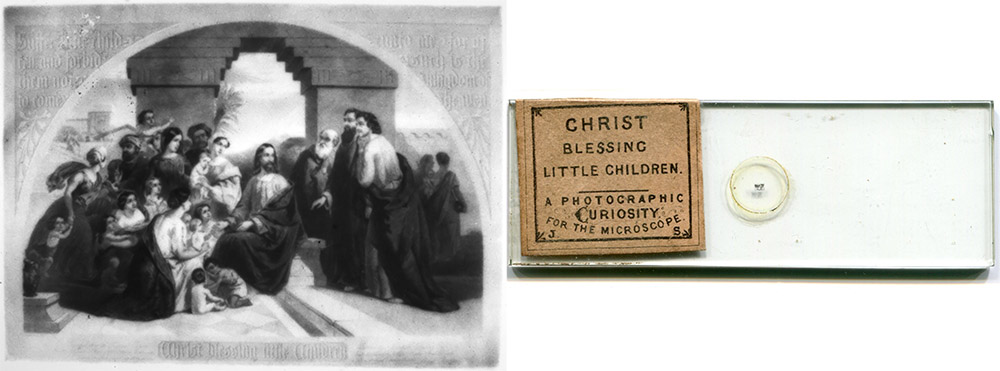
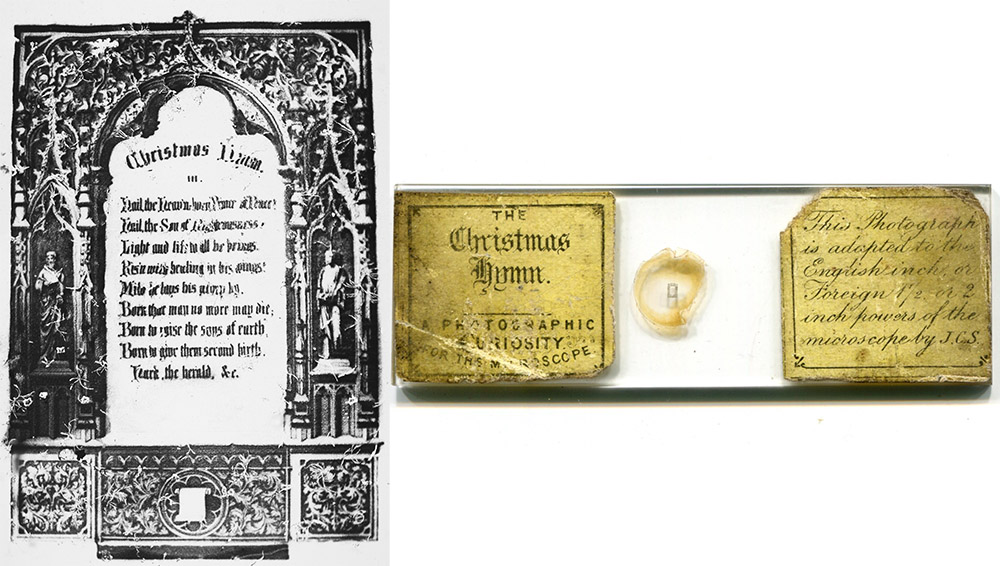
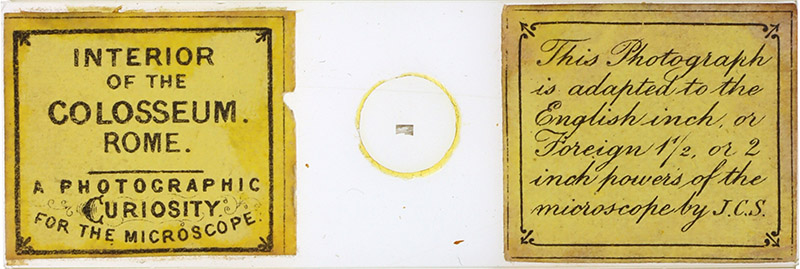
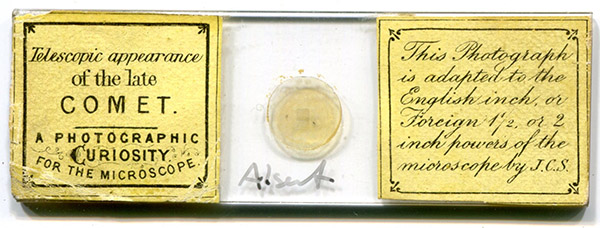
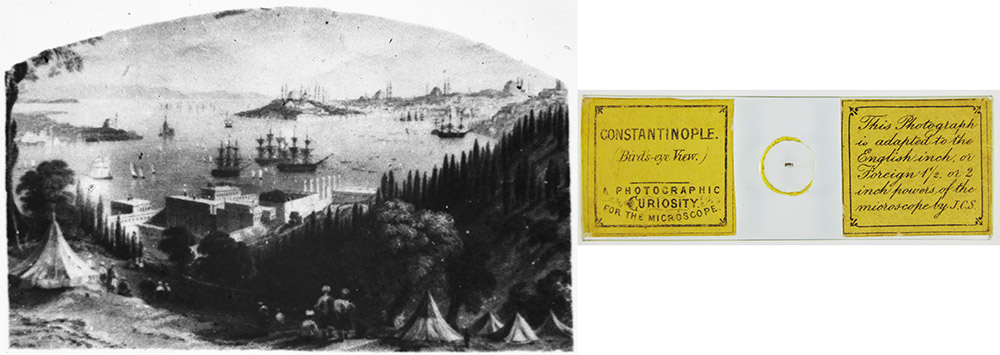
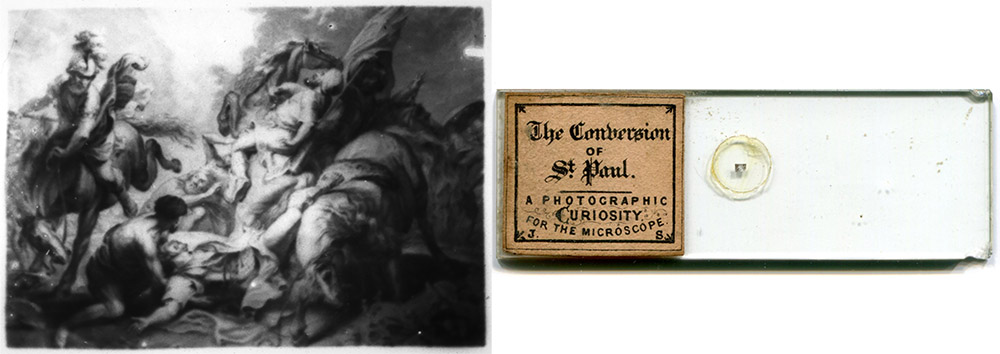
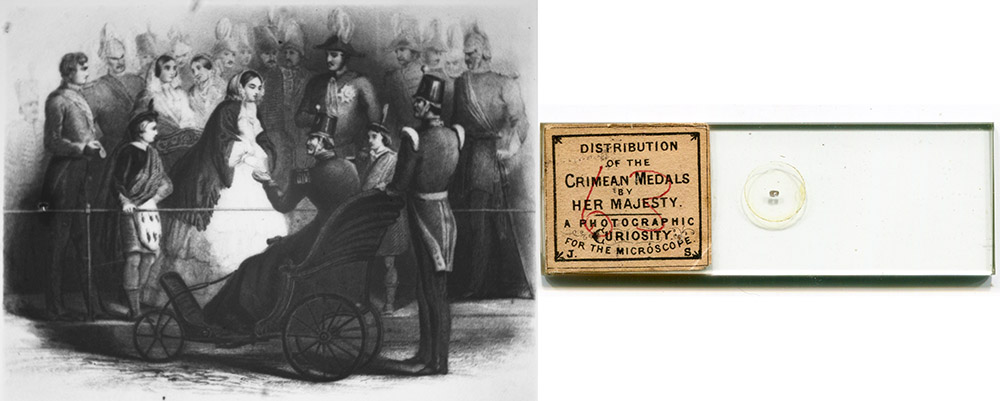
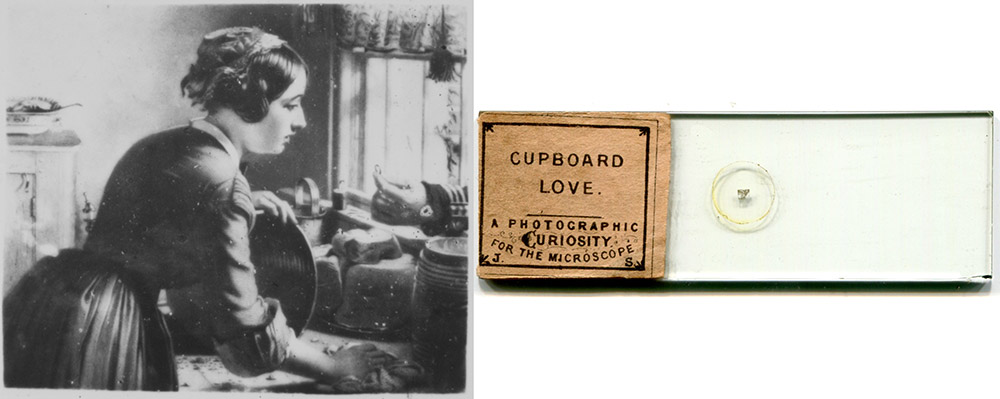
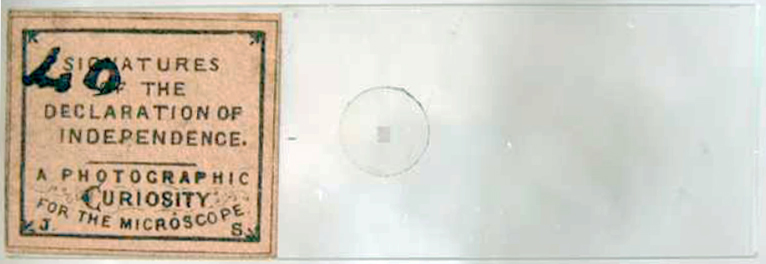
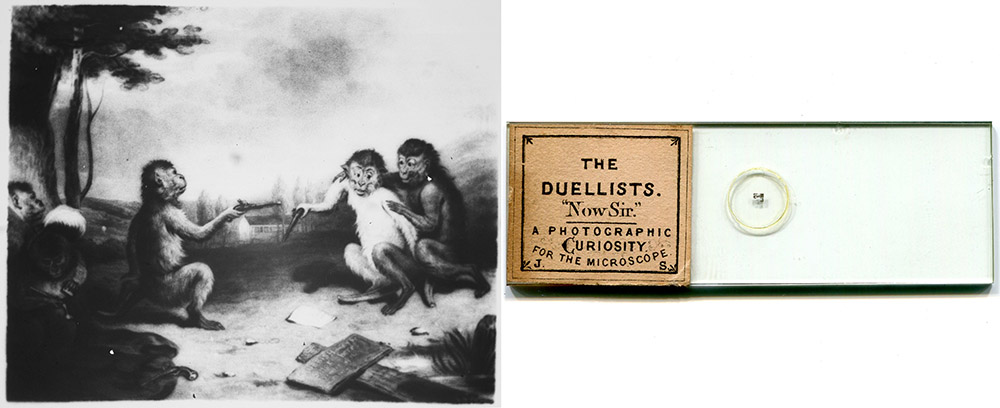
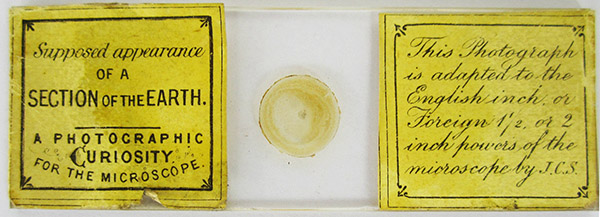
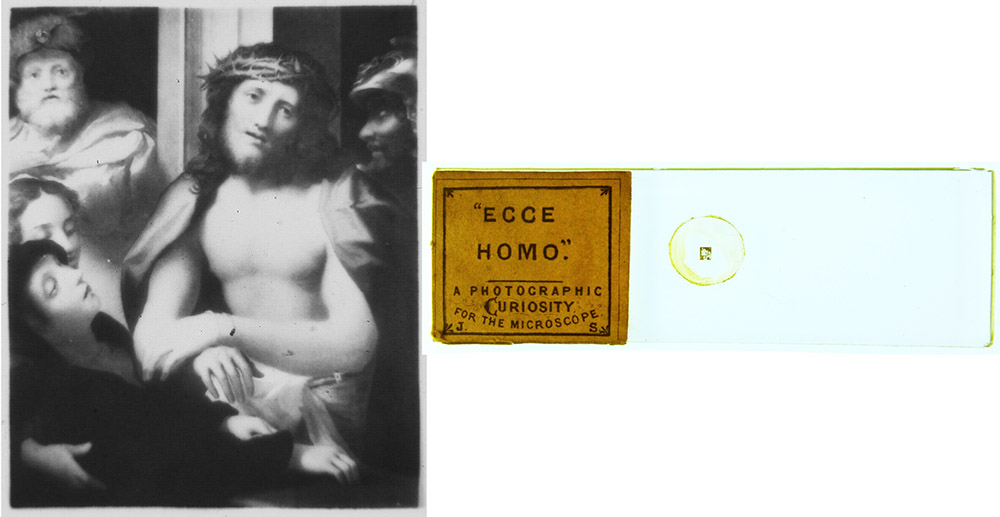
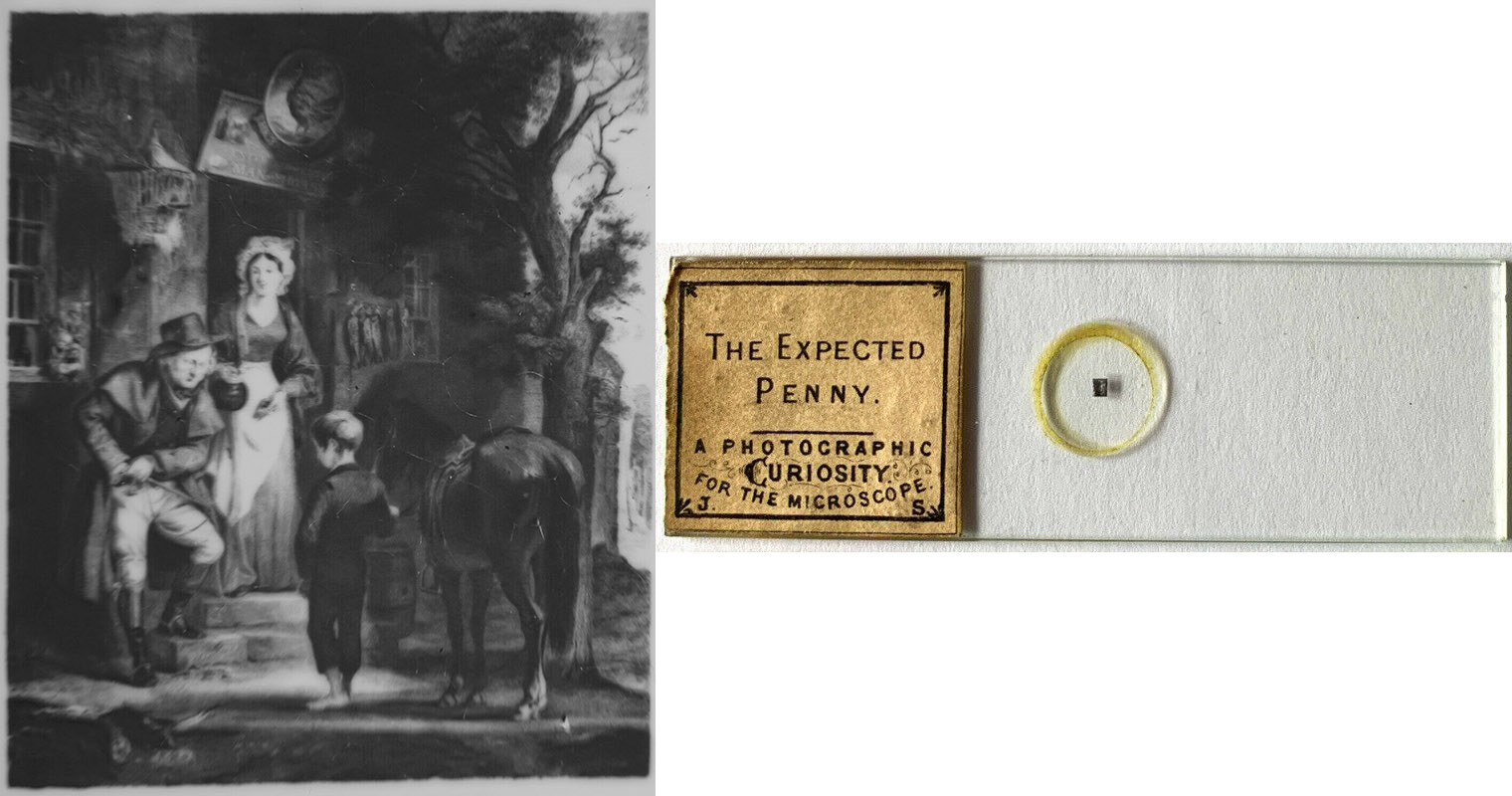
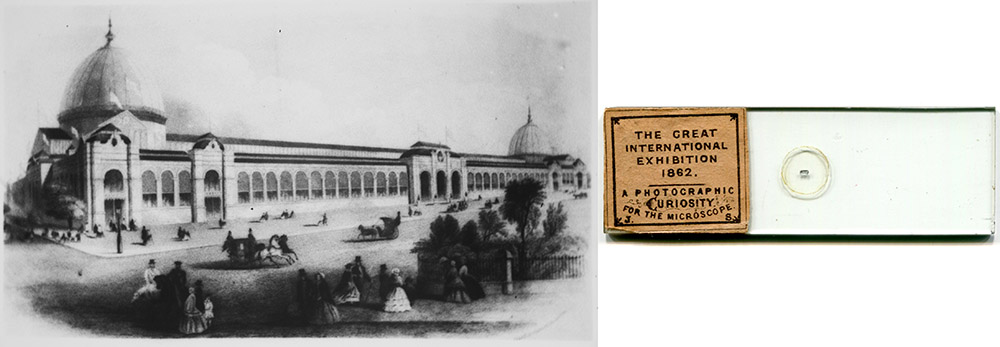

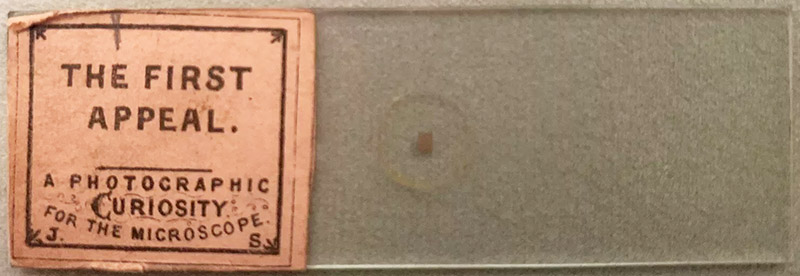

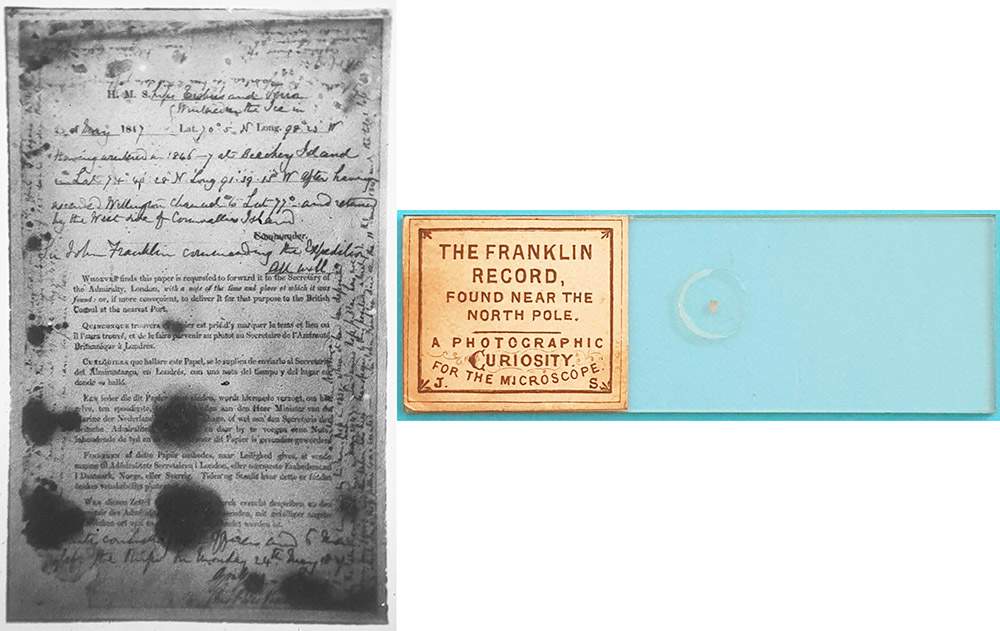

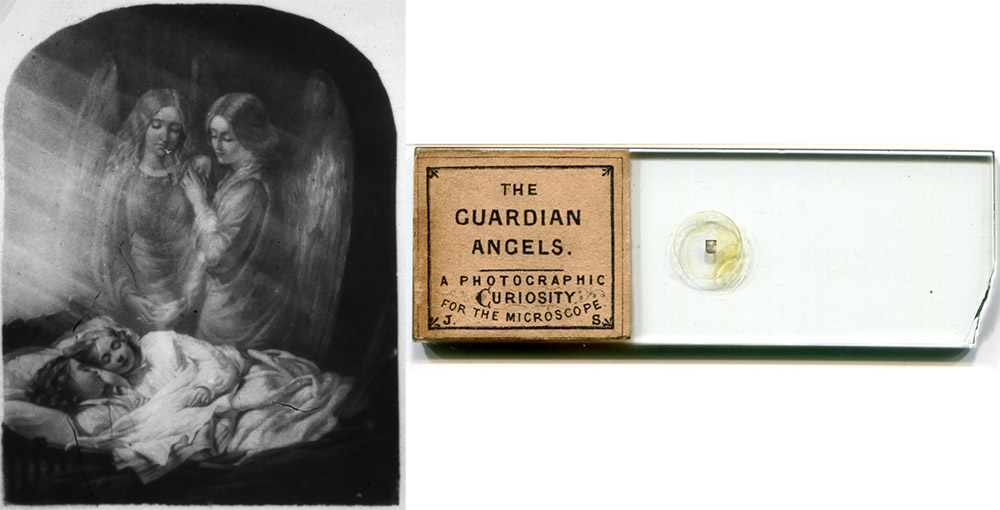
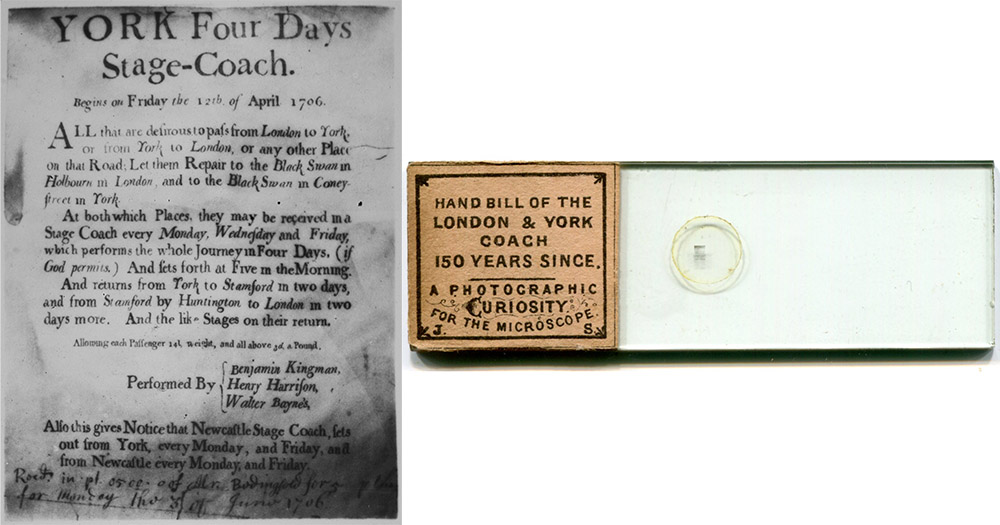
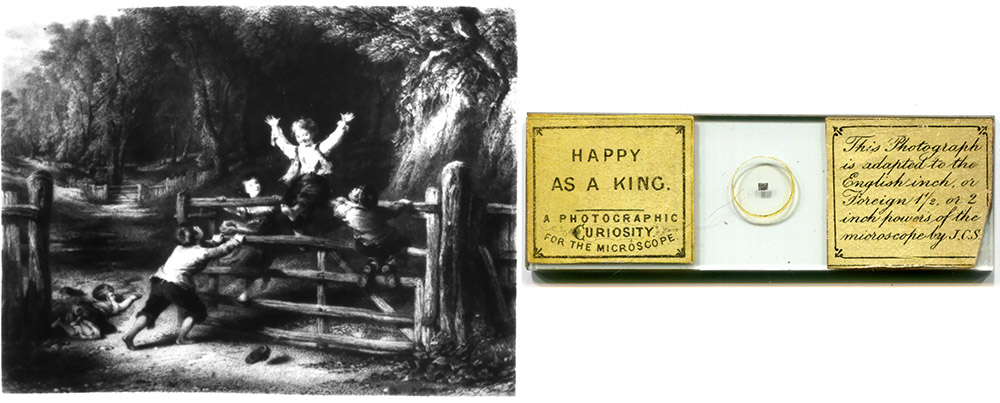
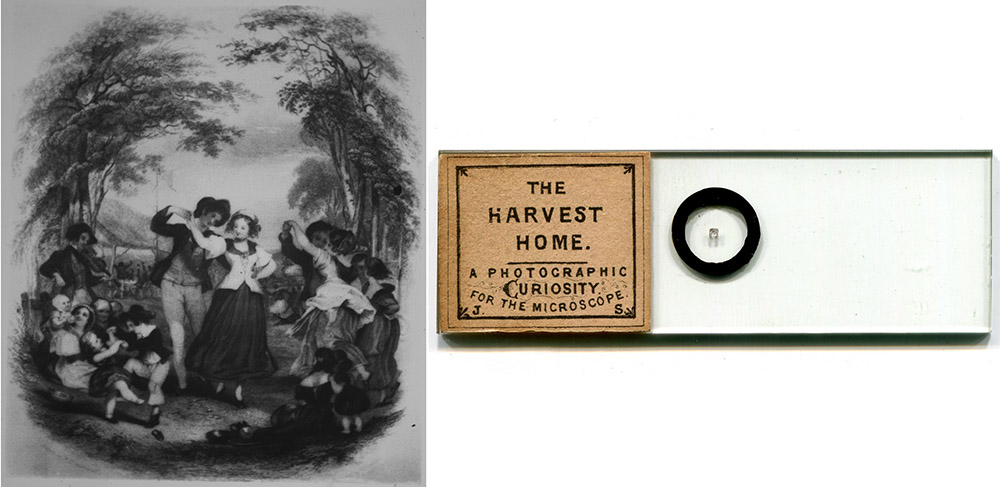
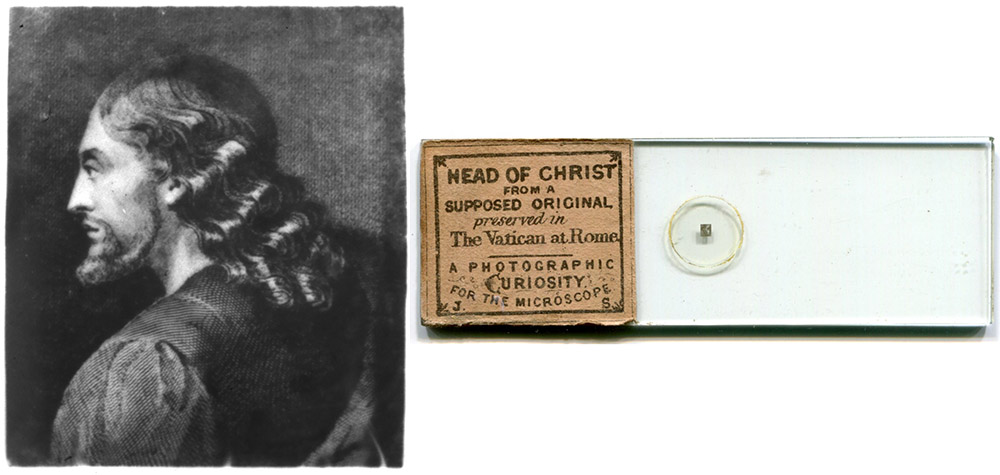
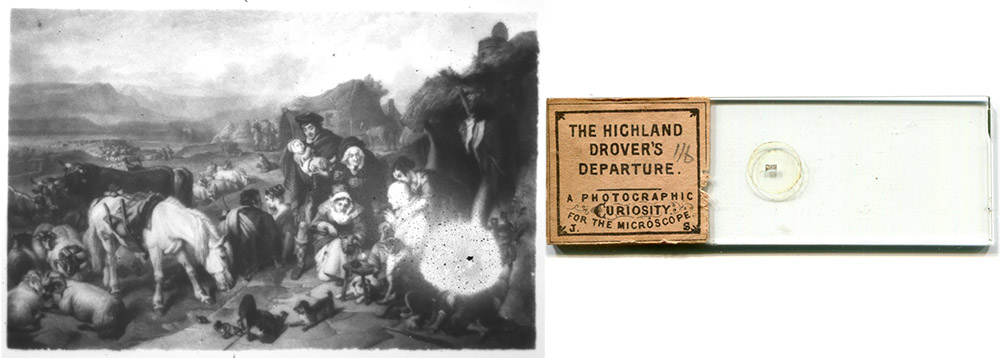
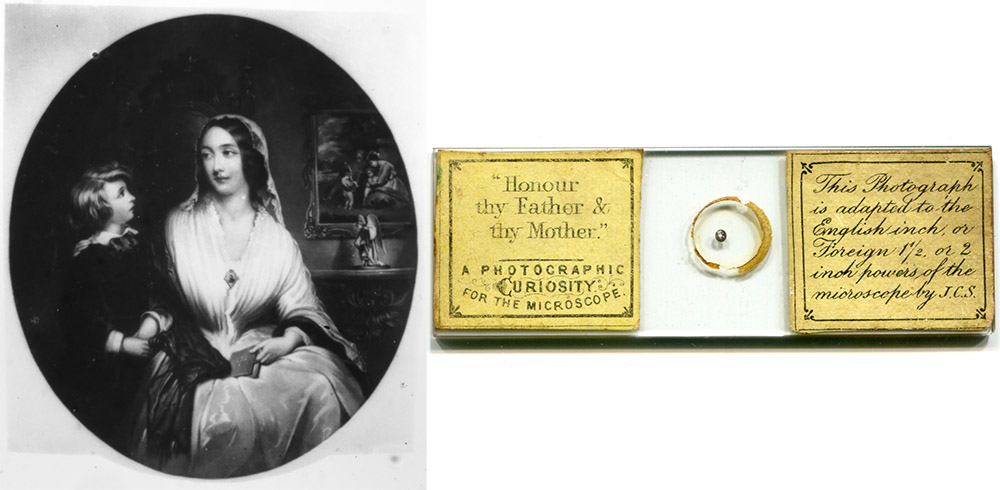
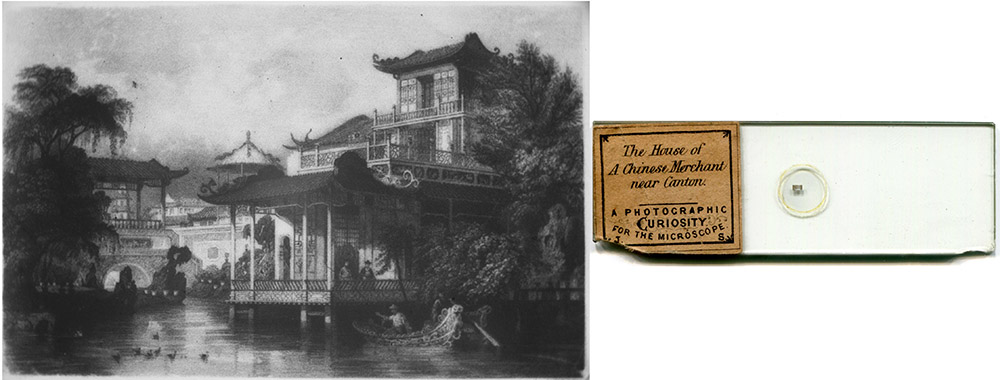
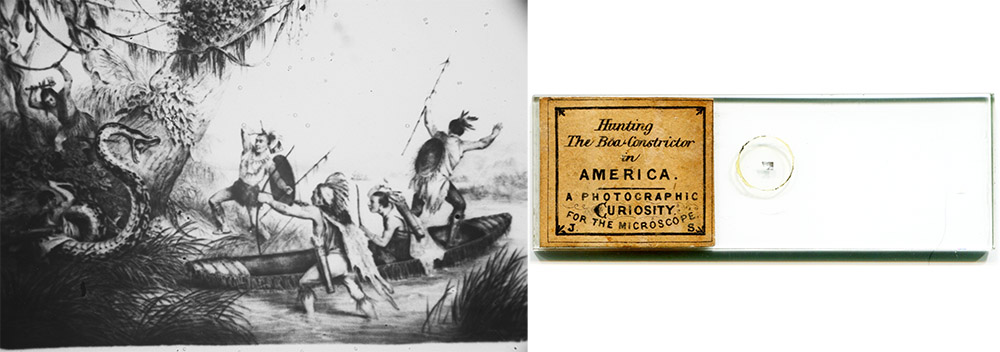
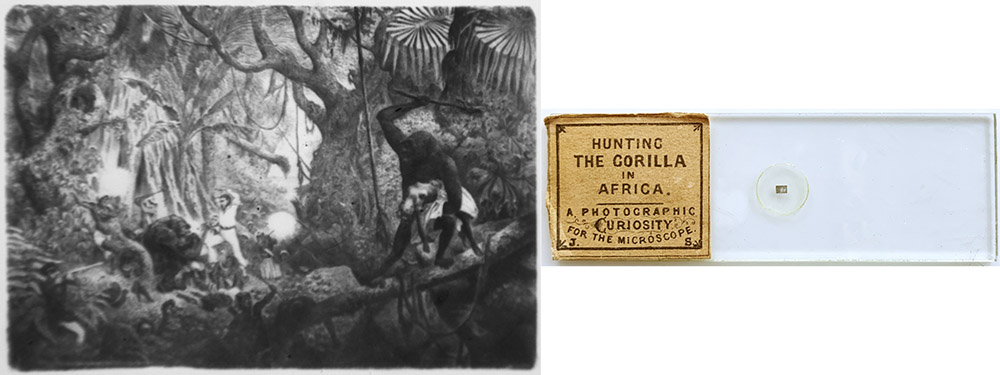
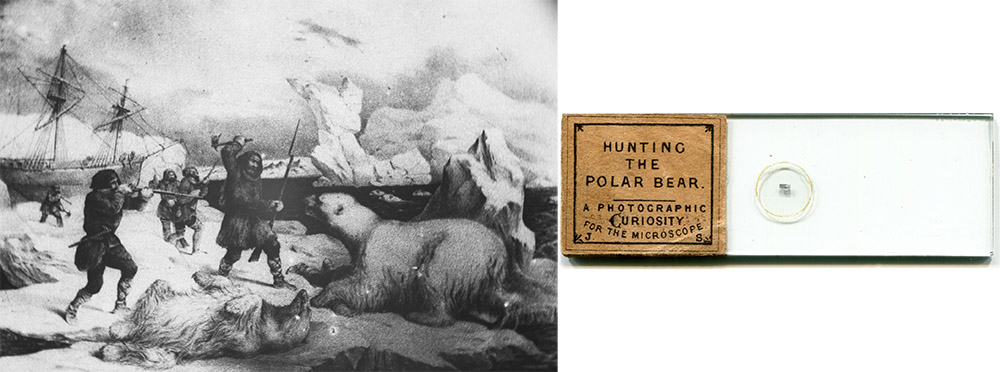
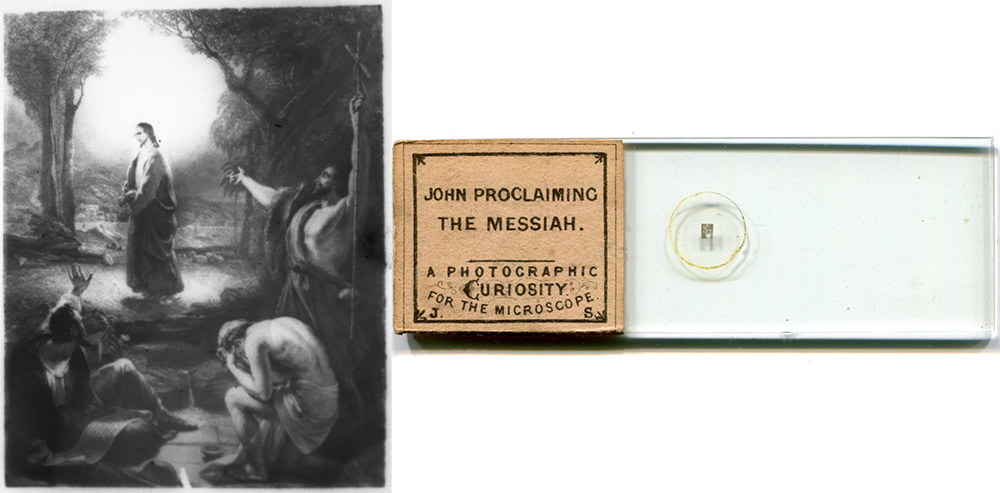

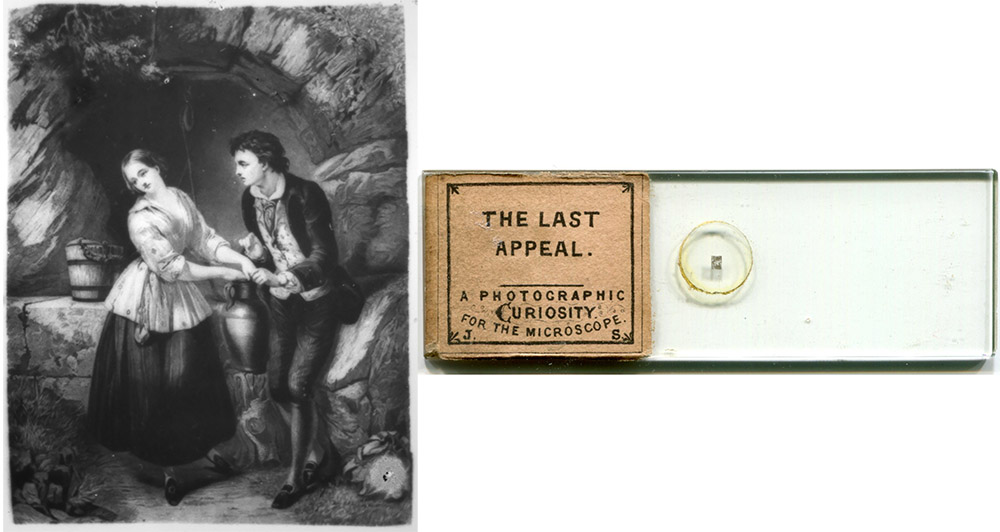
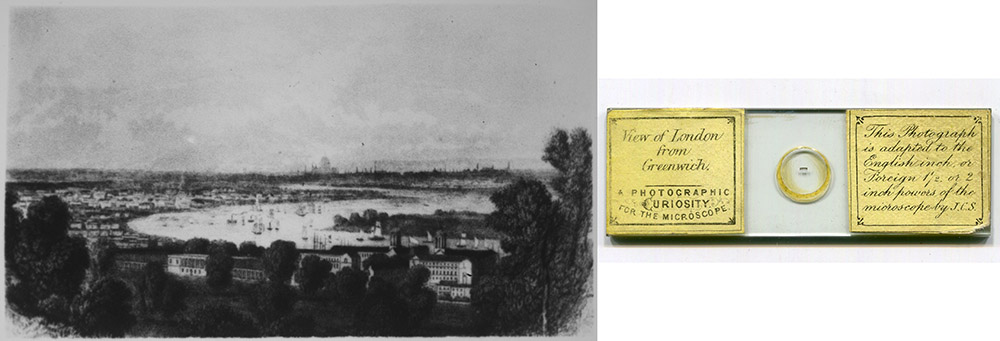
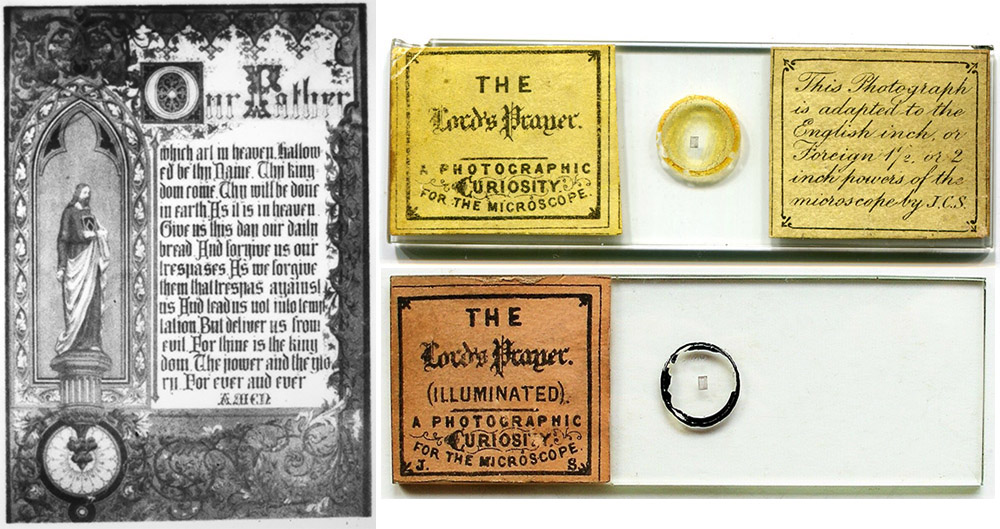
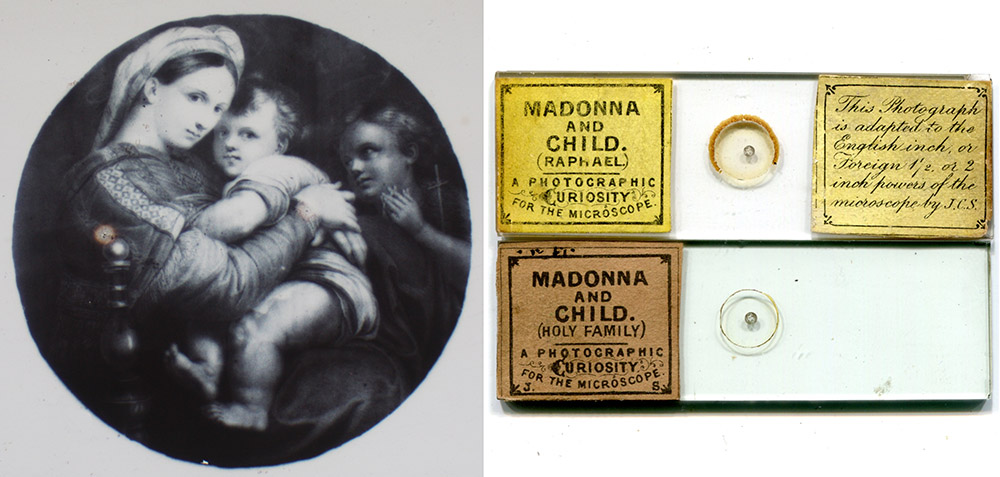

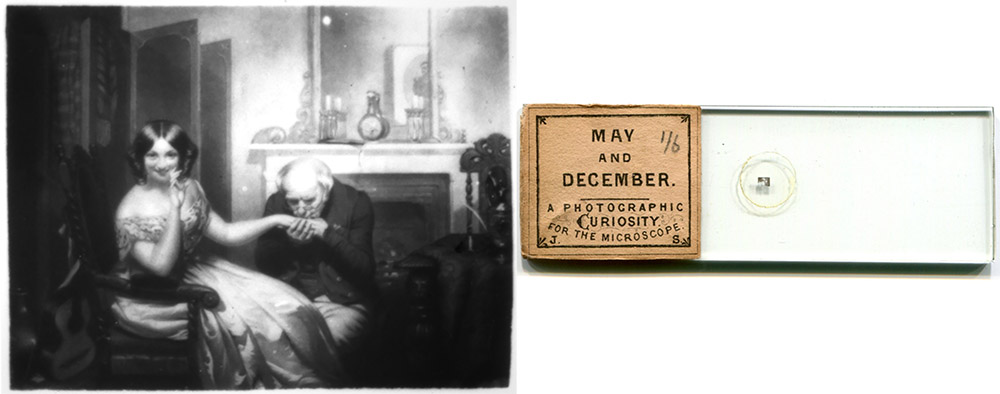
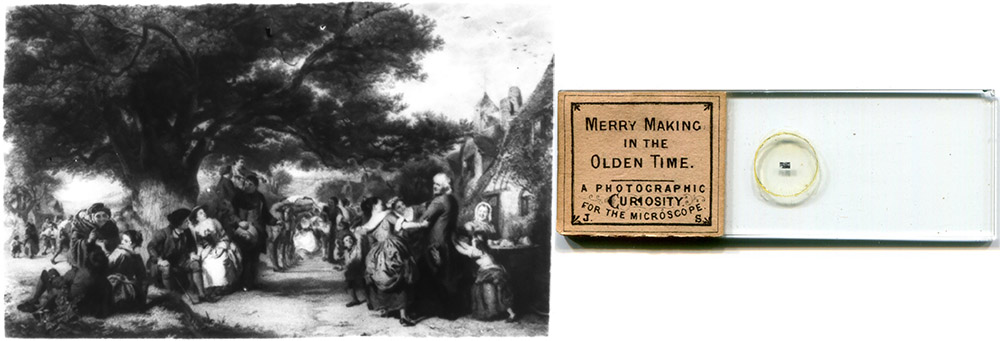
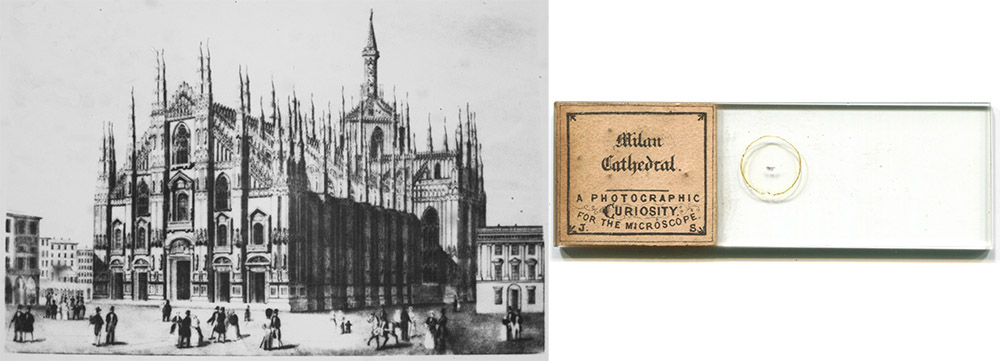

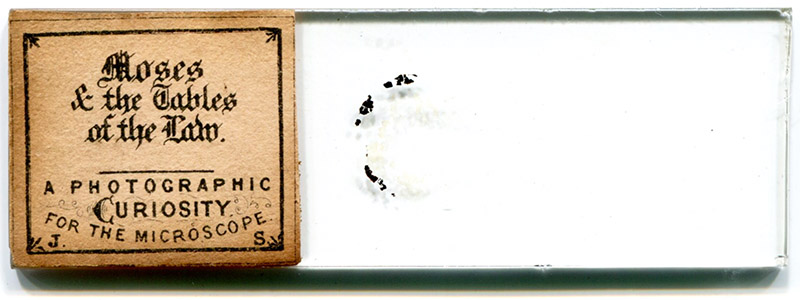
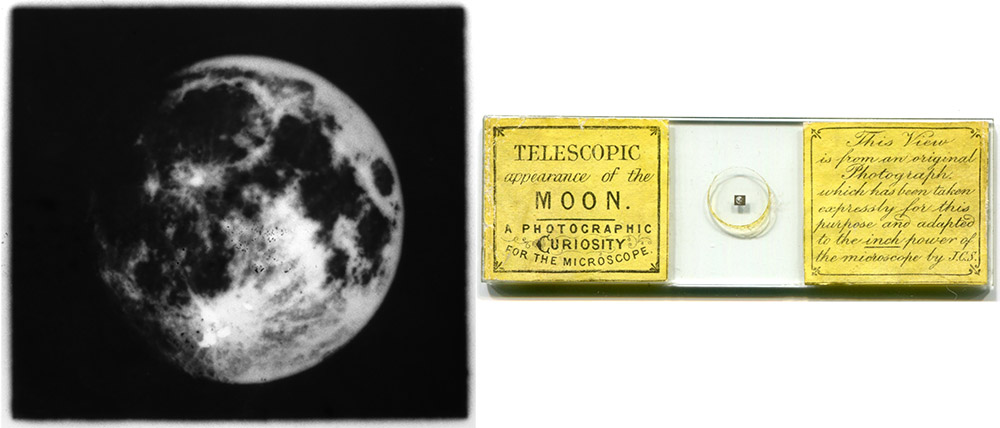
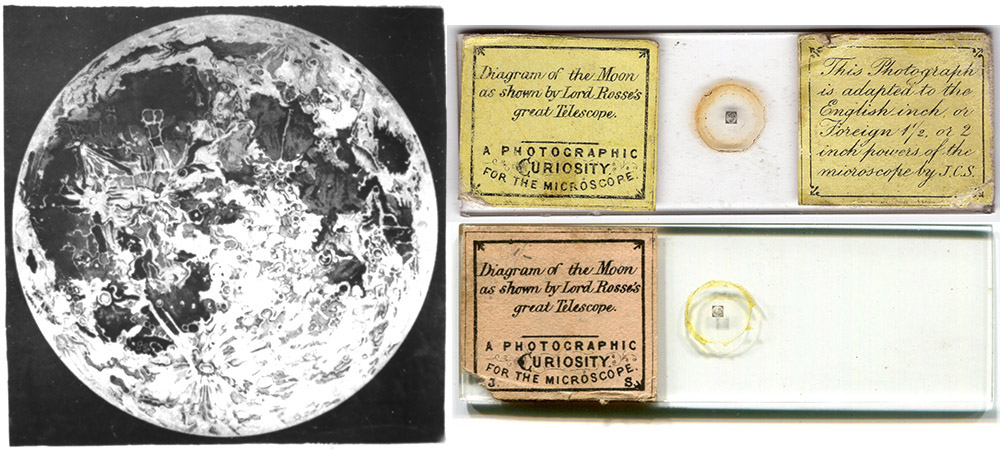
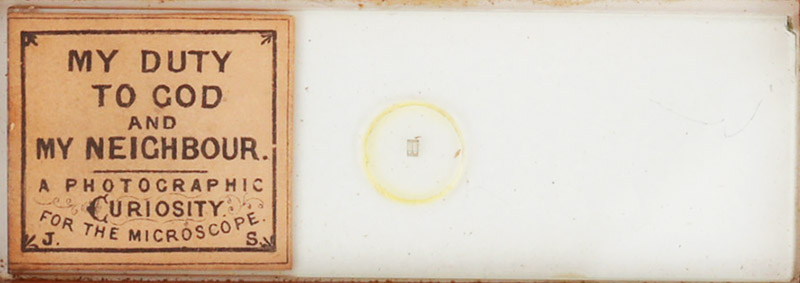
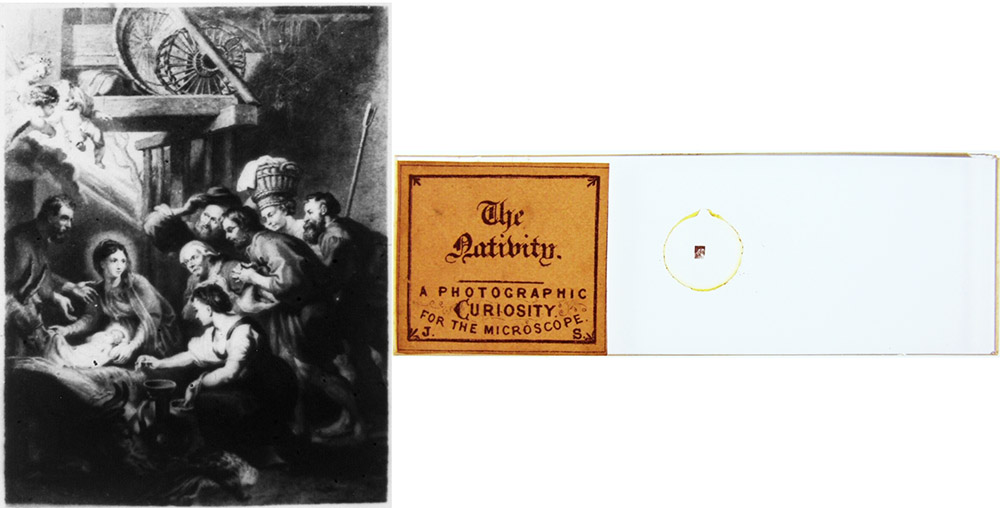

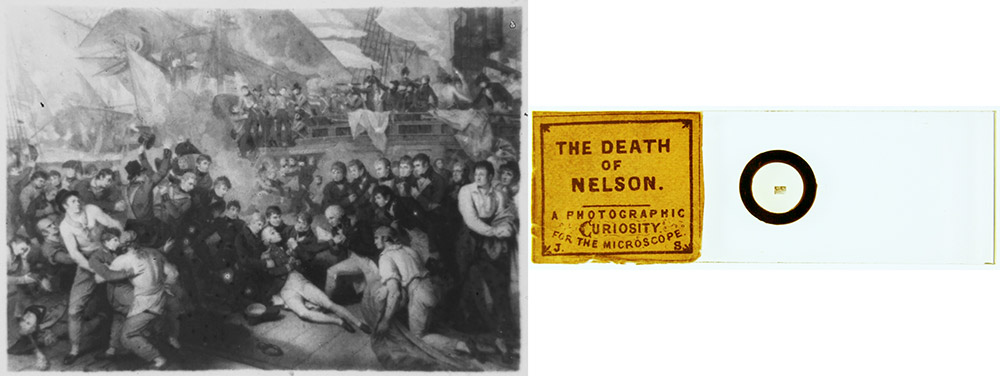
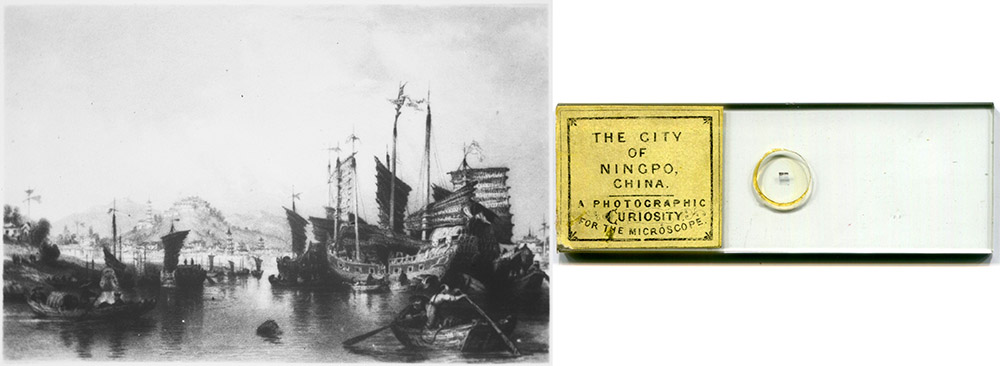
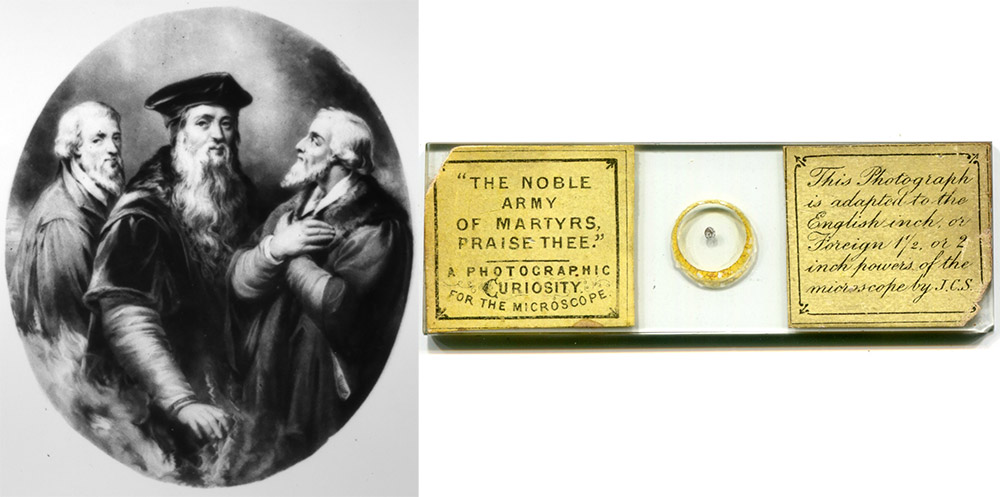
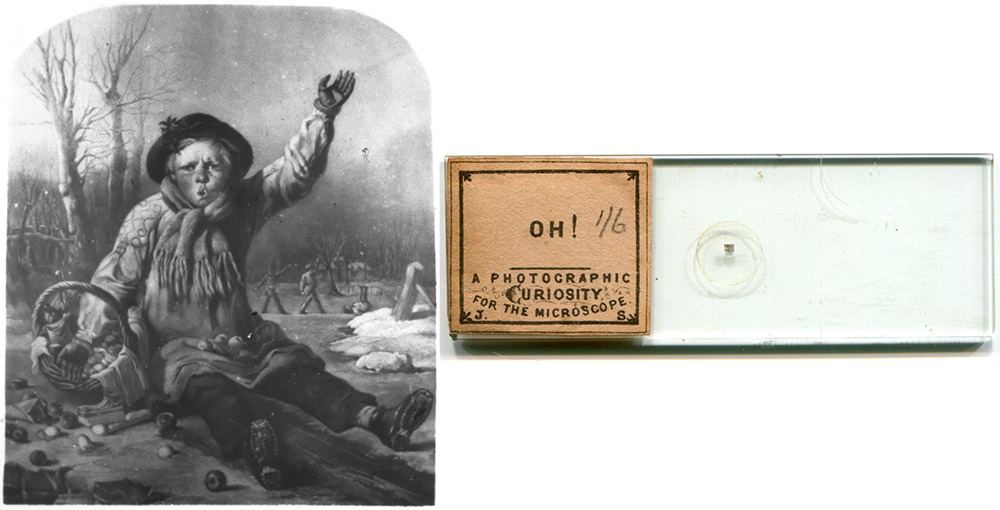
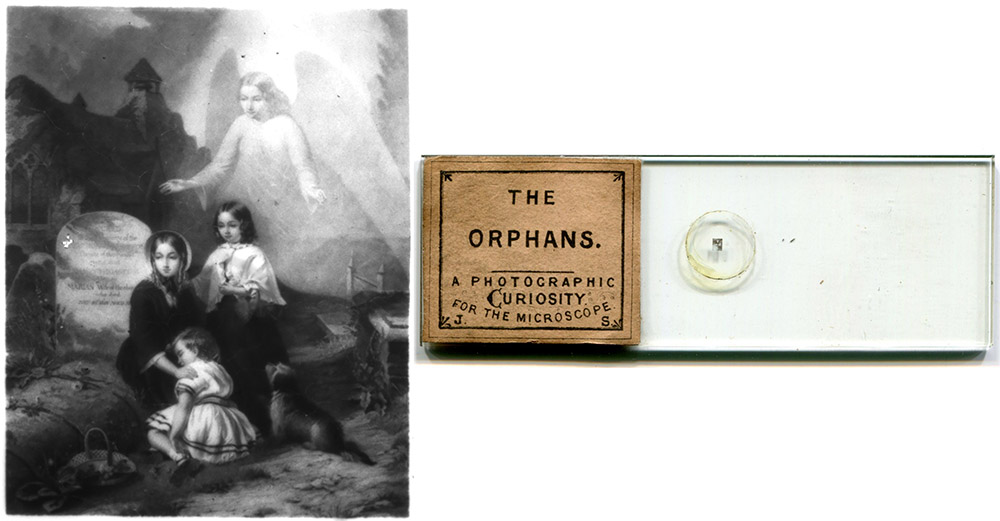
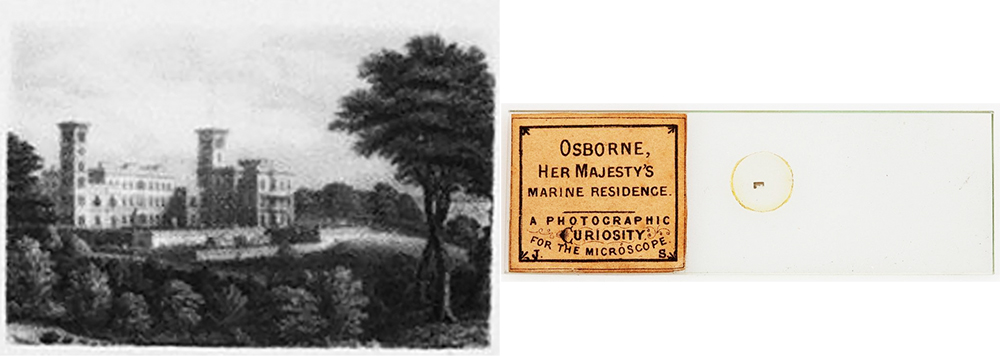
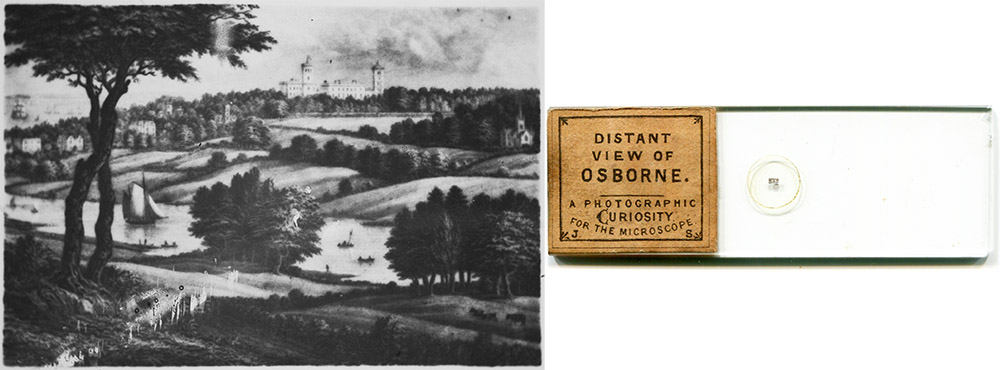

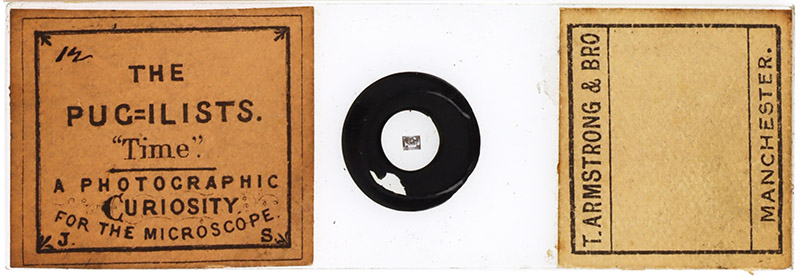
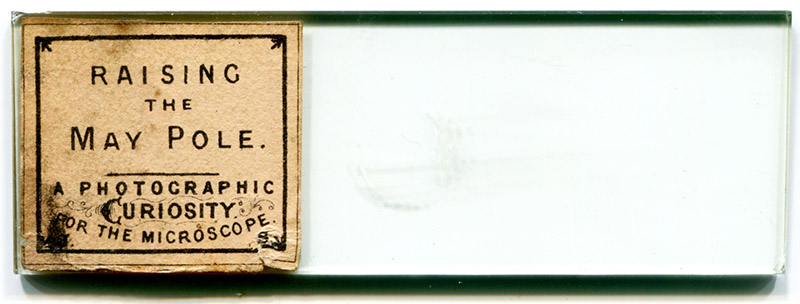
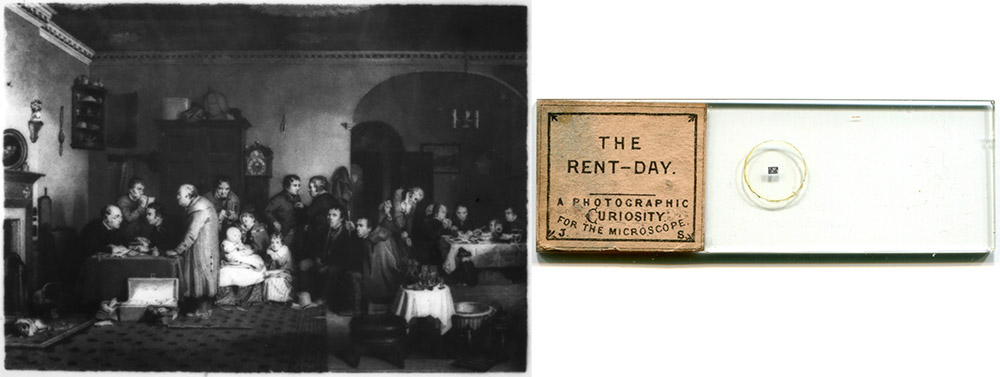
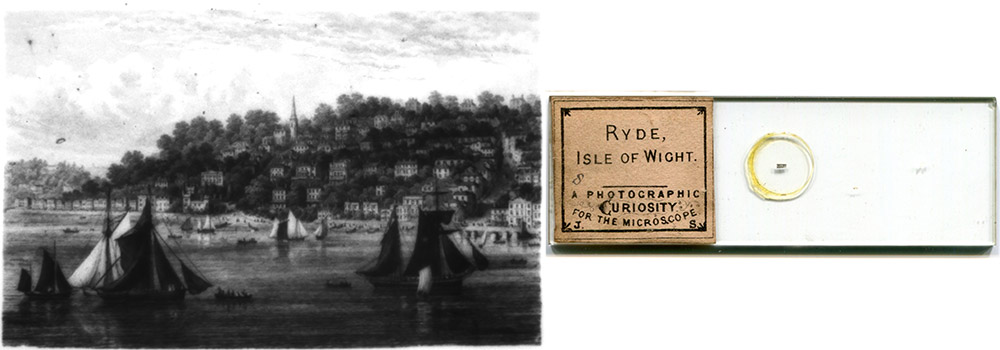
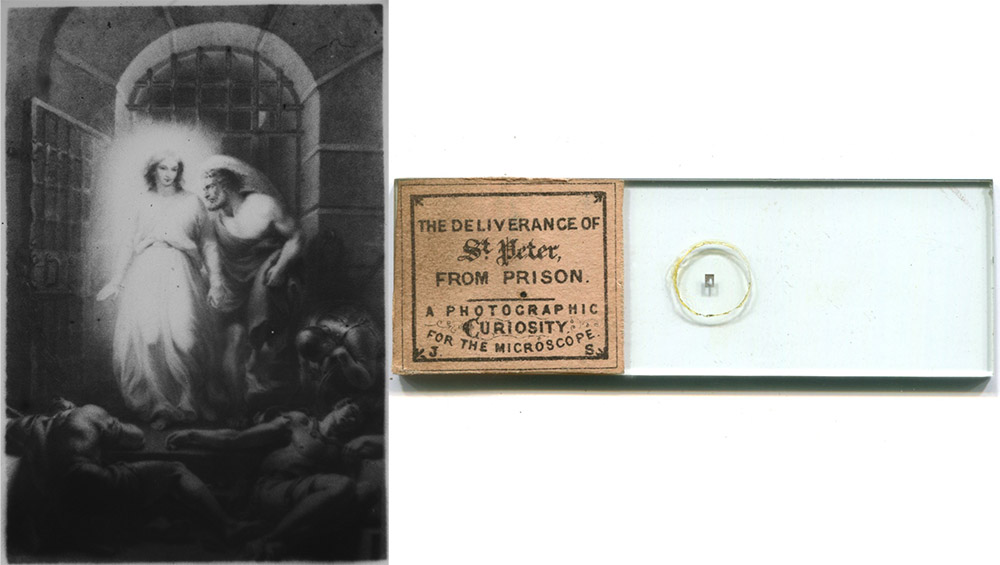

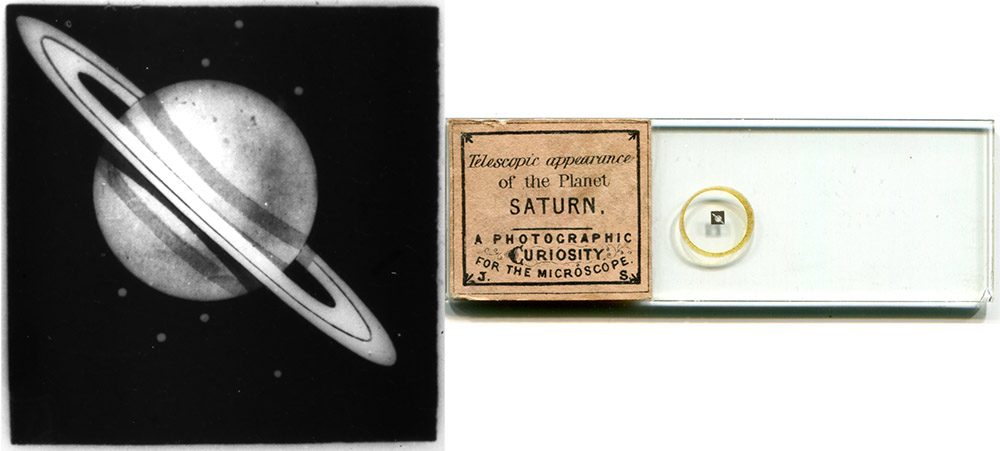
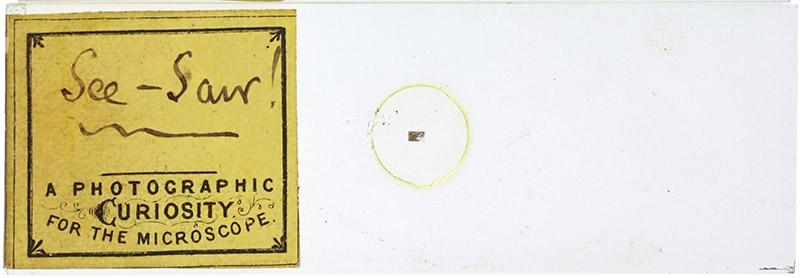
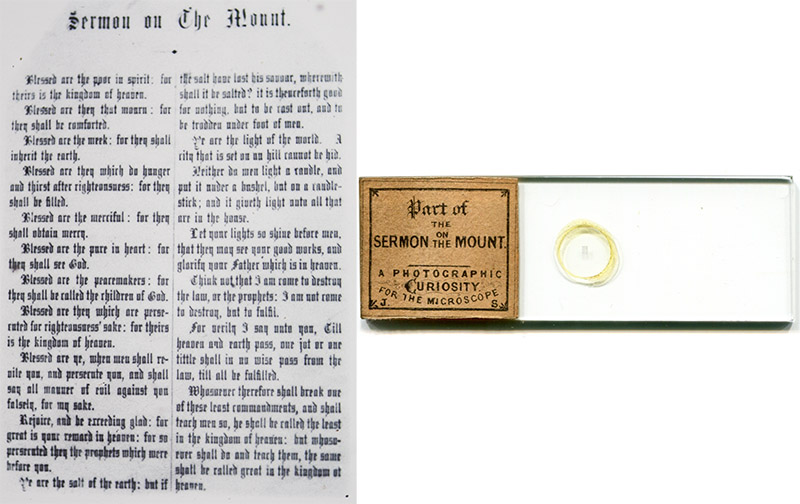
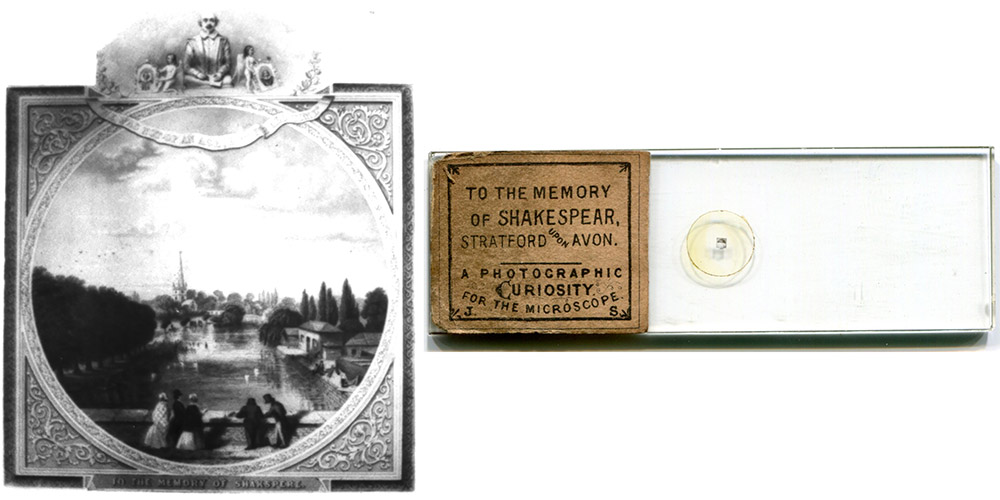
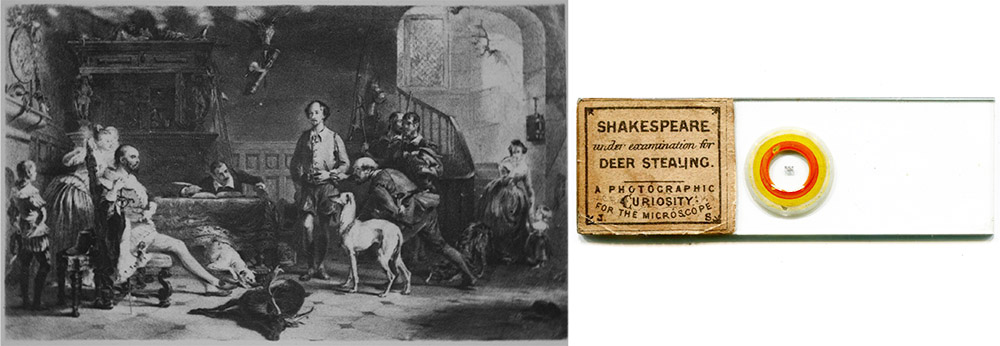
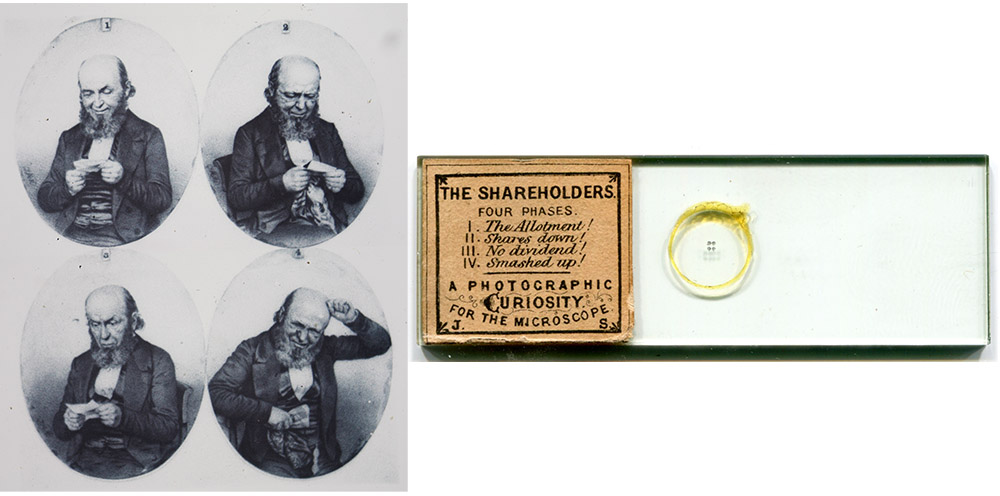
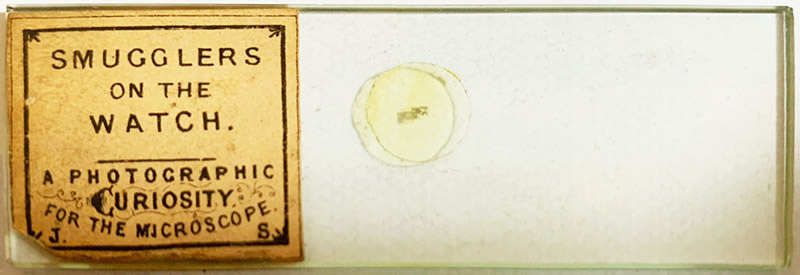
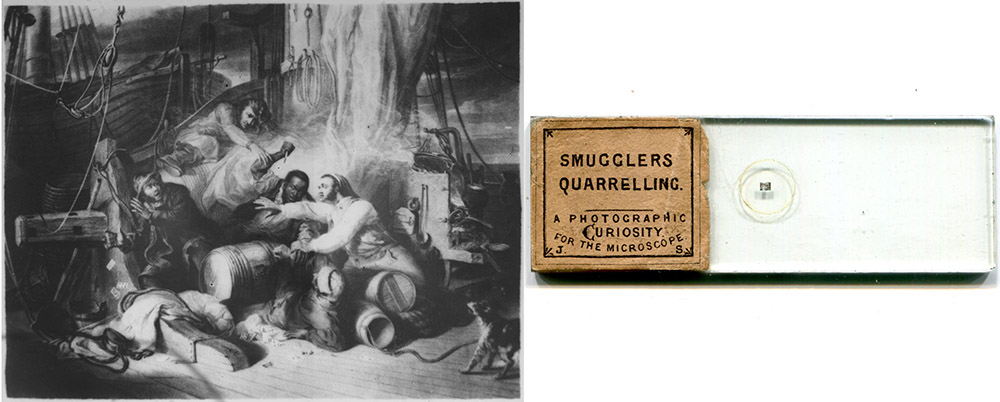
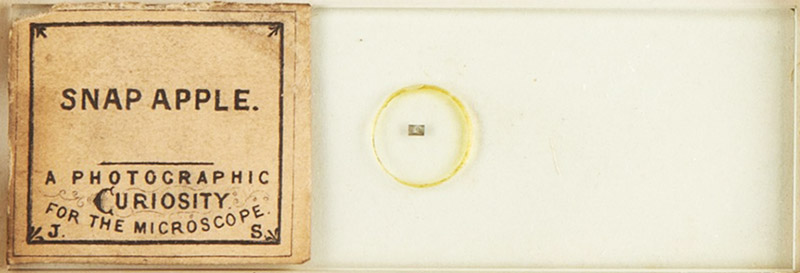
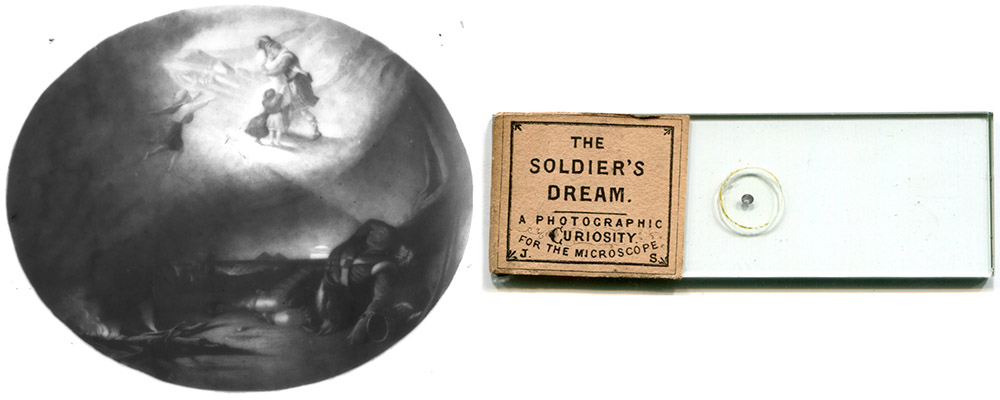
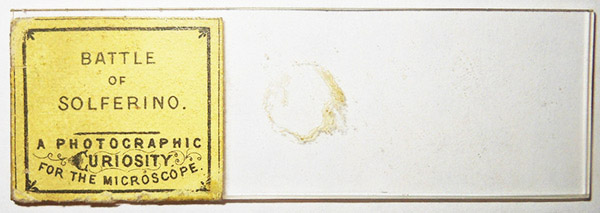


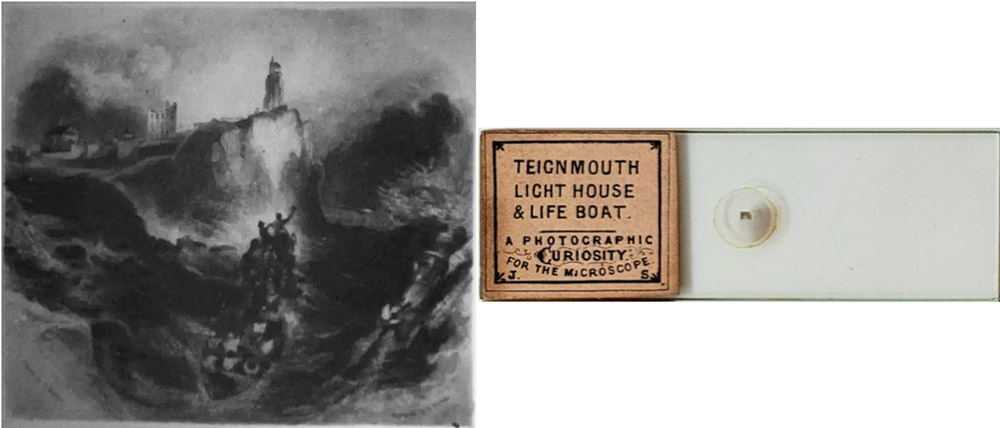
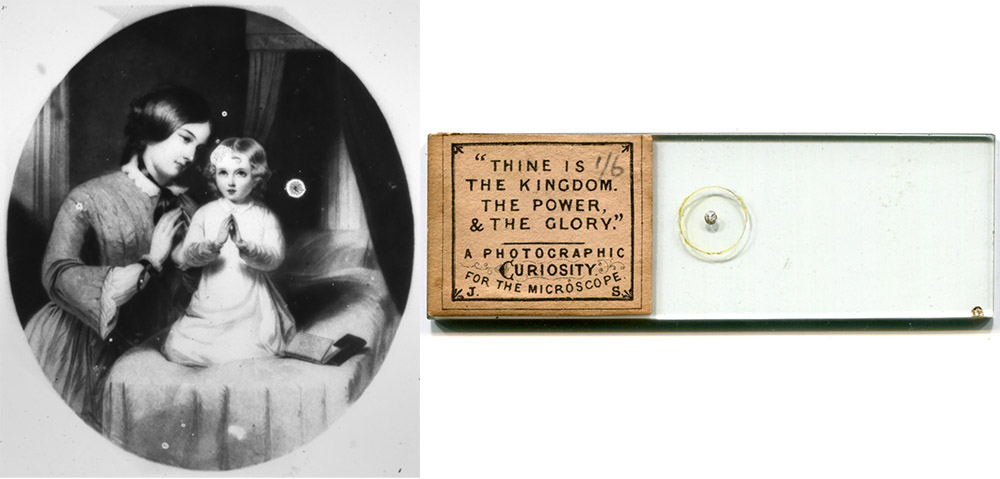

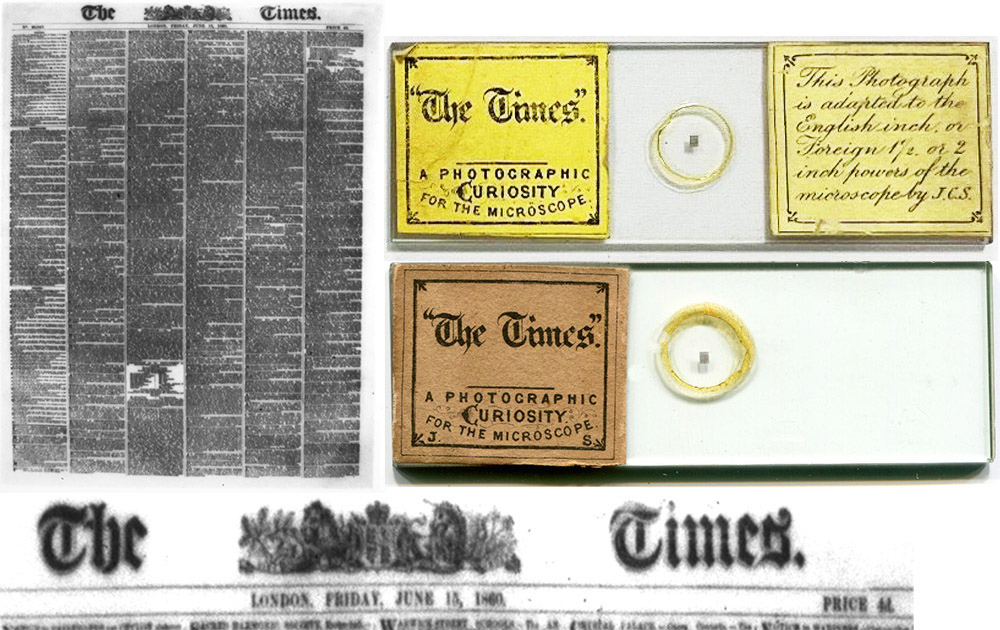
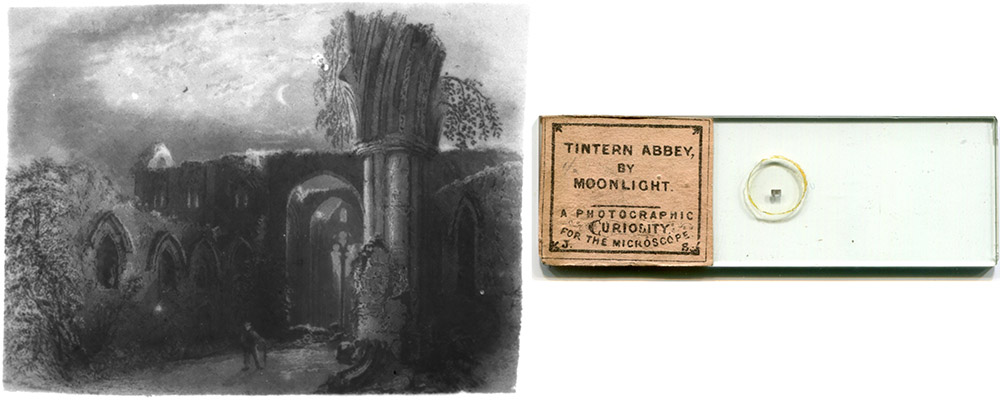
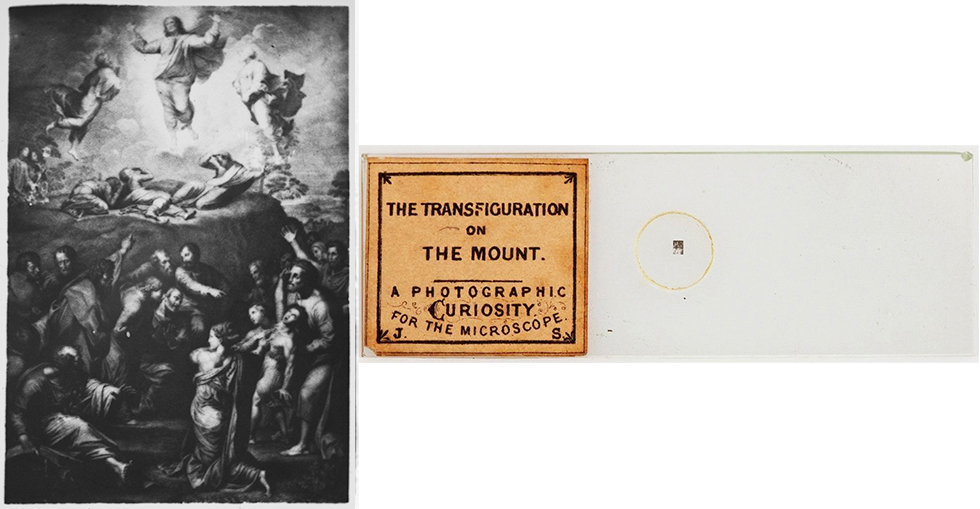
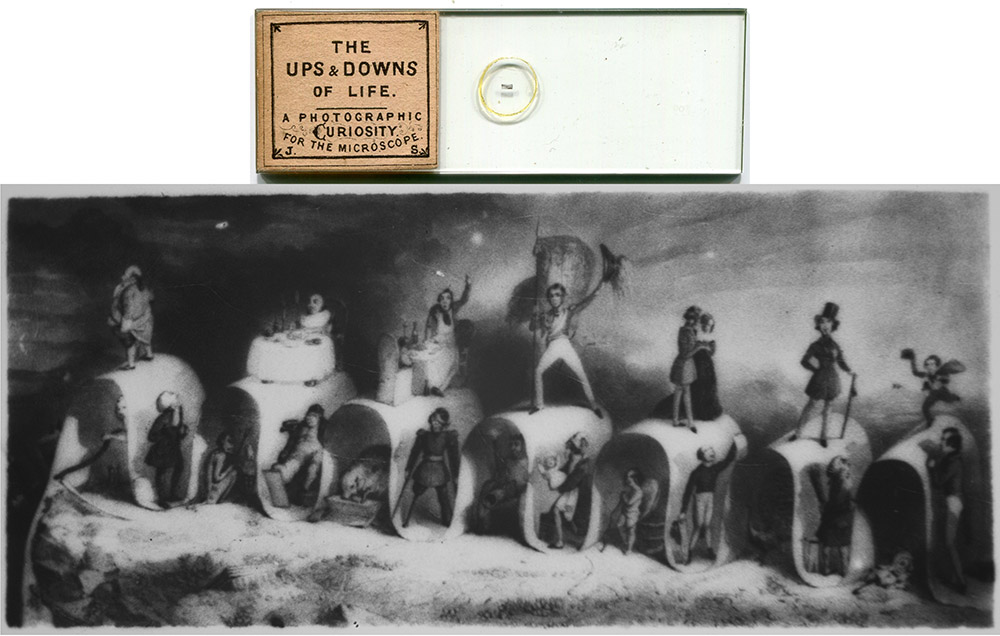
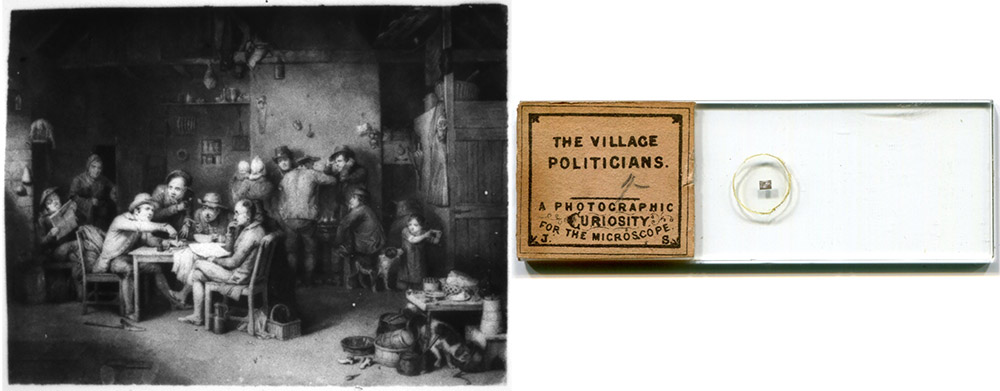
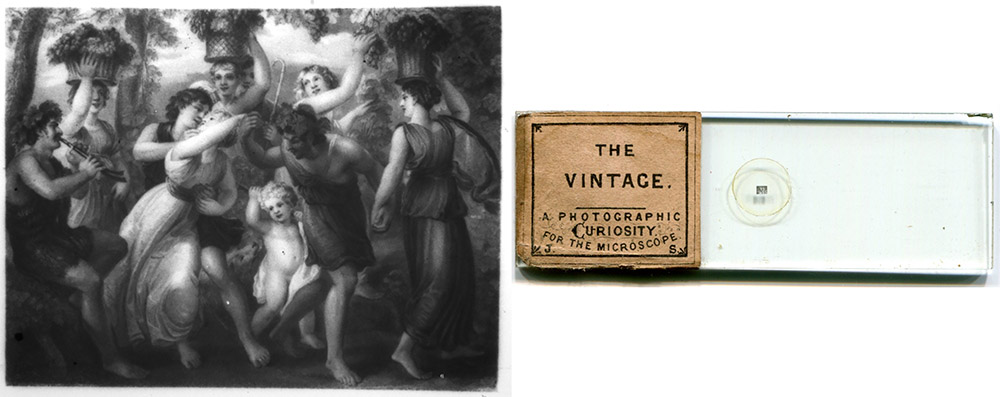
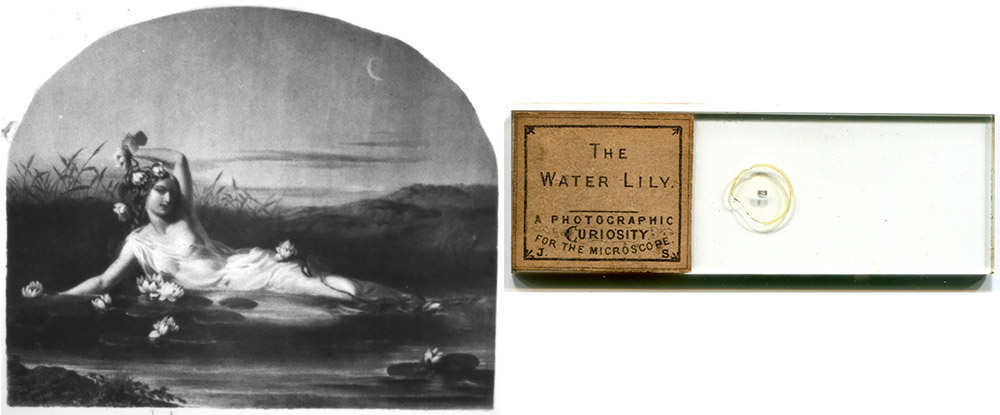
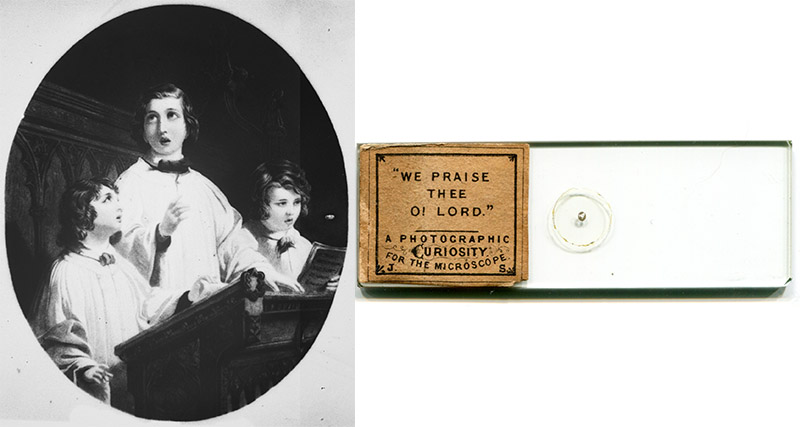
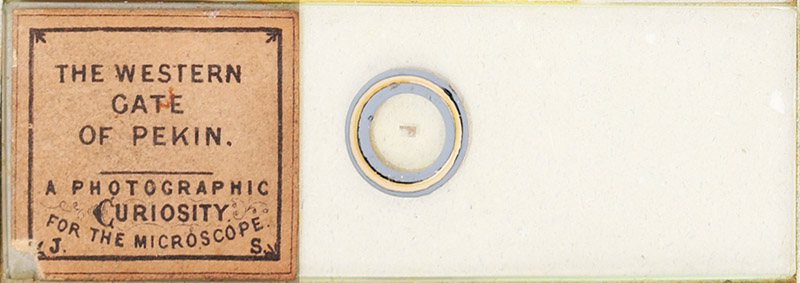
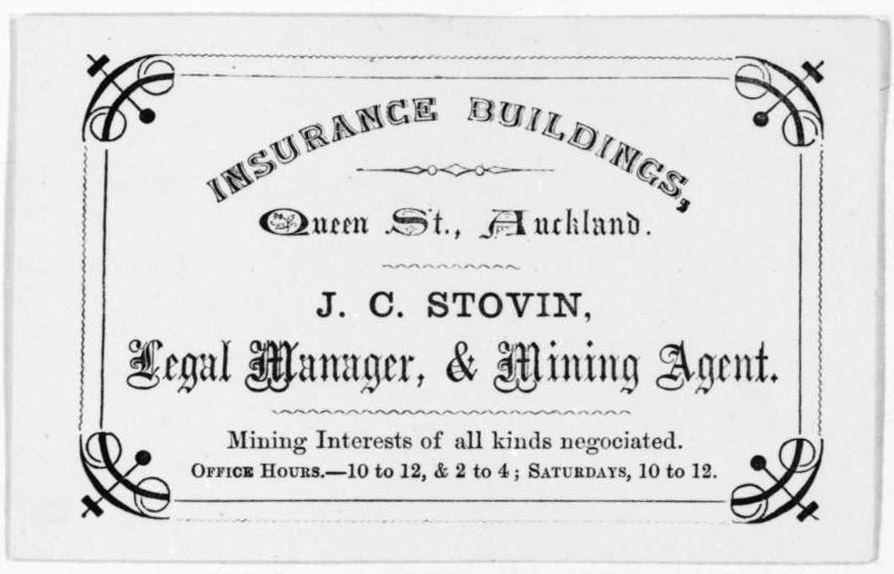
Figure 10.
J. C. Stovin's business card from New Zealand. He lived there between 1870 and 1880. Adapted for nonprofit, educational purposes from https://ndhadeliver.natlib.govt.nz.
Acknowledgements
Many thanks to Steve Gill and Diana Averina-Lugova for generously sharing information on J.C. Stovin’s life.
Resources
Bracegirdle, Brian (1998) Microscopical Mounts and Mounters, Quekett Microscopical Club, London, pages 57 and 196, Plate 46-J and 46-K
Bracegirdle, Brian, and James B. McCormick (1993) The Microscopic Photographs of J.B. Dancer, Science Heritage, Chicago, page 54
Burial record of John Charles Stovin (1896) April 7, Putney St. Mary
The Bury and Norwich Post, and Suffolk Herald (1865) The Provincial Banking Corporation, Ltd., list of partners, Tuesday, February 14, 1865
Christening record of George Foster Stovin (1859) December 11, Chelsea St. Luke
Daily News (London) (1852) Ecuador committee, Wednesday, March 17, 1852
Daily News (London) (1866) Notice of winding up of the Rossa Grande Mining Company by John Charles Stovin, Tuesday, January 2
England census, birth, marriage and death records, accessed
through ancestry.co.uk and genesreunited.co.uk
Electoral roll of Franklyn, New Zealand (1870-1871) John
Charles Stovin, leaseholder of Lot 3, Kapanga, Coromandel, page 62
Electoral roll of Auckland West, New Zealand (1875-1876)
John Charles Stovin, freeholder living at his business at Hepburn St.,
Auckland, page 34
The Gentleman's Magazine (1846)
Marriage of John Held, R.N., and Mary-Ann-Elizabeth Stovin, Vol. 26, new
series, page 314
The Gentleman's Magazine (1851)
Marriage of J. Charles Stovin and Mary Jones, Vol. 35, new series, page 545
Giordano, Raymond V. (2006) Singular Beauty: Simple Microscopes from the Giordano Collection, page 58, illustration 112
Golby, F.W. (2006) A Century of Masonic Working: Being a History of the Stability Lodge of Instruction, Kessinger Publishing, page 211
Joint Stock Companies Directory (1867) Charles Barker and Sons, London, page 1289
The Law Times (1852) Vol. 19, page 2140
International Exhibition Official Catalogue of the Industrial Department (1862) page 51
Marriage record of George Foster Stovin and Jane Collins
(1881) Dunedin, New Zealand. Accessed from familysearch.org
Marriage record of John Charles Stovin and Elizabeth Russell
Curling (1863) St. Luke Chelsea
The Mirror of Parliament (1840) Battersby’s divorce bill, Vol. 2, pages 1517-1518
New Zealand Herald (1870) "Passengers inwards ... per S.S. City of Melbourne, from Sydney and Melbourne, Saloon ... J. Stovin", January 12 issue, Page 8
New Zealand Herald (1880) "Departures, April 27, Zealandia .. for Honolulu and San Francisco. Saloon passengers ... J.C. Stovin", May 24 issue, Page 6
Newton’s London Journal of Arts and Science (1865) Patent 839, Vol. 21, page 373
Nicol, John (1881) News from the North, British Journal of Photography, Vol. 28, page 149
Patents for Inventions (1865) pub. by the Patent Office, page 713
The Photographic News (1863) The International Exhibition, Vol. 7, pages 227
PhotoLondon (accessed 2011), Stovin, and Stovin & Thorp, https://www.photolondon.org.uk/#/details?id=7428
The Standard (London) (1838) Court of Common Pleas, Charge of bigamy, Thursday, February 01, 1838
Taranaki Herald (1870),
Advertisements, Vol. 18, issue 993, 15 June 1870, page 3
Transactions of the Royal
Society of New Zealand (1881) Geology, Vol. 14, page 424
The United Service Magazine (1835) Courts-martial, part 3, page 127
Warren, Stanley (2006) Photographic curiosity slides – the
identification of JS and JCS, Micro
Miscellanea, Newsletter of the Manchester Microscopical and Natural History
Society, Issue 63, Pages 15-17
Warren, Stanley (2009) Studying microphotographic slides, an
update to current knowledge, Journal of the Microscope Historical Society., Vol. 17, pages 35-50
Warren, Stanley E. (2014) The Micrograph, Micro Miscellanea, the Newsletter of the Manchester Microscopical and Natural History Society, Issue No.85, Spring, pages 14-24














































































































































